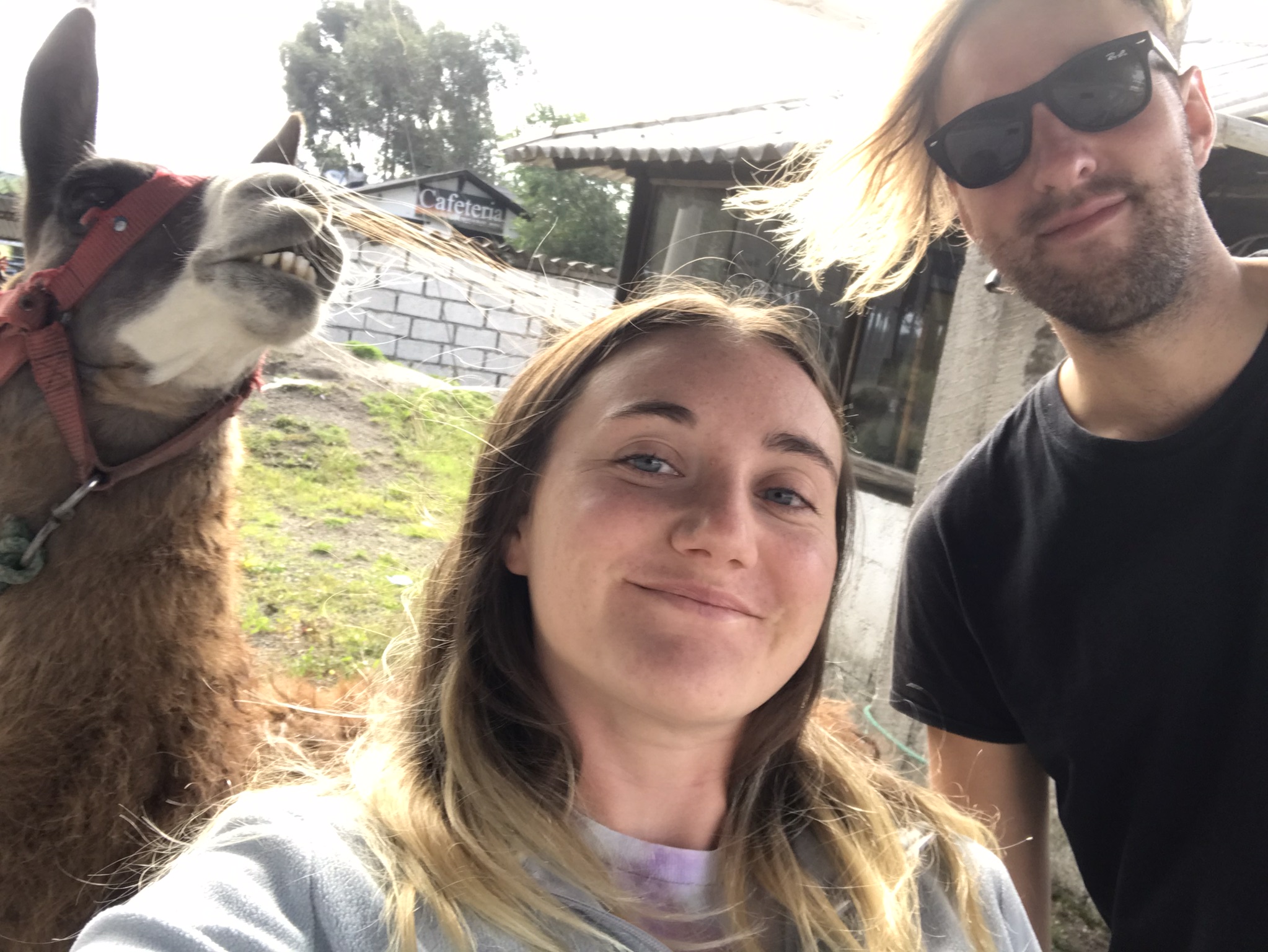India’s sixth largest state by population, Tamil Nadu is a unique state in many ways. Distinctly South Indian, it is the home of the Tamil people, one of the largest sub-ethnic groups in India. Tamil Nadu is the second largest non-Hindi speaking state in India after West Bengal, and to us it felt much further removed from the northern Hindi-speaking states. Entering Tamil Nadu felt like stepping into a different country. Check out our Tamil Nadu travel experiences below!
Chennai, Mahabalipuram, Puducherry, Thanjavur
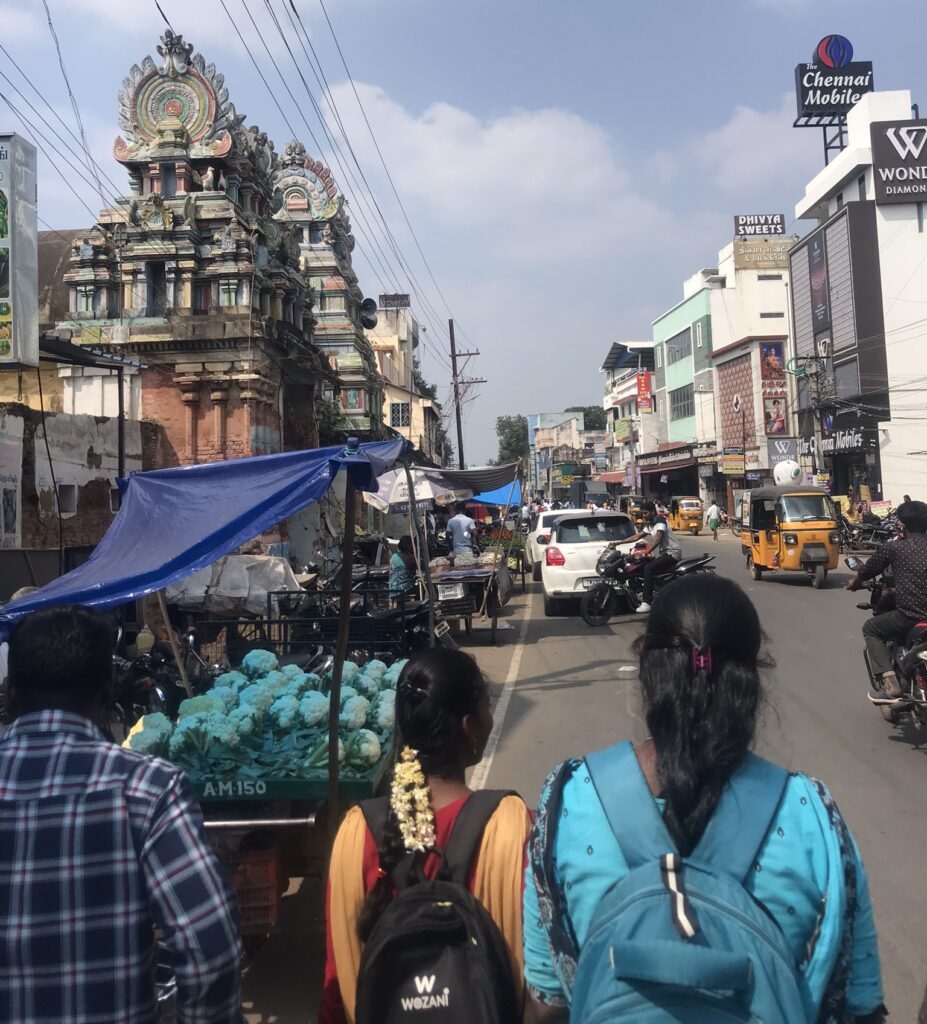
The Tamil people are fiercely proud of their unique culture and language. Tamil is an ancient Dravidian language that is said to be one of the oldest in the world which is still in modern use. The land has seen the rise and fall of several important dynasties and empires, such as the Cholas whose influence in the early 11th century spread as far as South East Asia. Other local ancient dynasties such as the Pallavas and the Pandyas contributed greatly to the development of art and culture and left a rich cultural heritage within the region.
Tamil Nadu is home to some of the most impressive and distinctive Hindu temples in India. The temples in Tamil Nadu follow the Dravidian style so are quite different from those in the north. Tamil temples are colourful, with pyramidal towers and large ornate entrance gateways. Although Hinduism is the dominant religion, the Dravidian Hinduism practiced in Tamil Nadu is not the same as that in the north of India – Tamils do not celebrate Holi, for example.
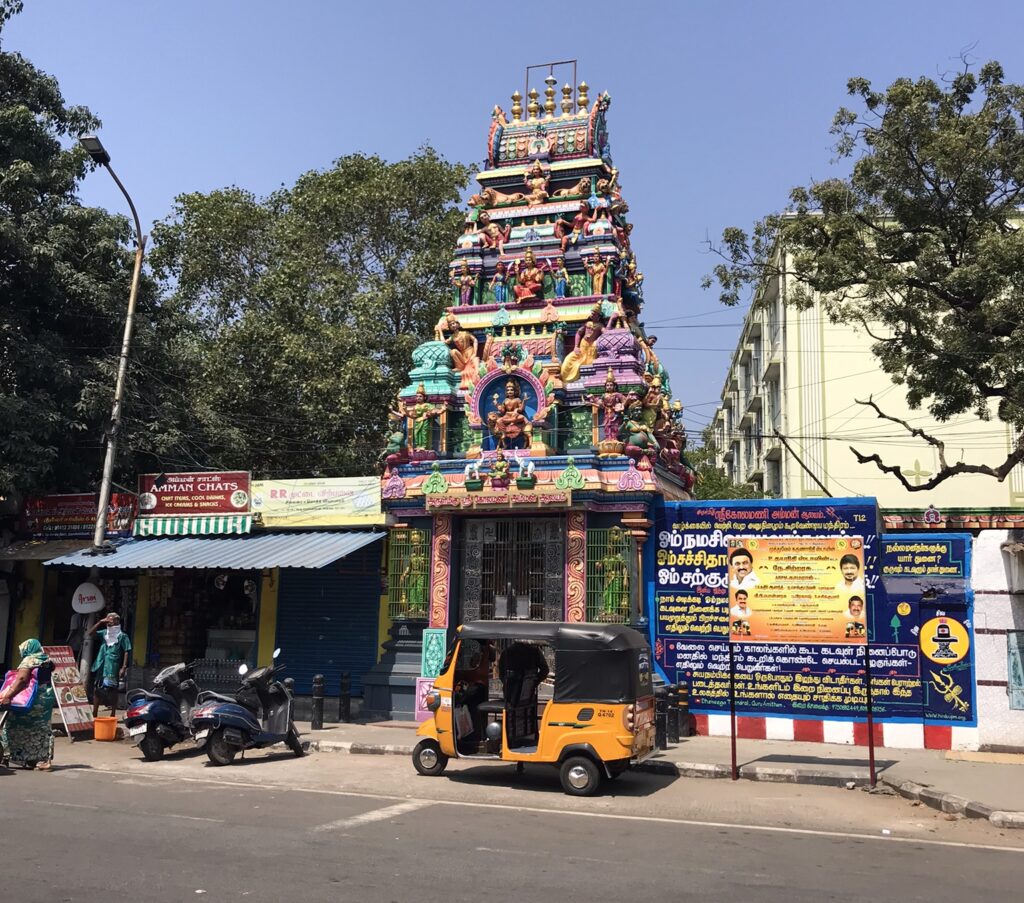
Colourful Hindu shrines can be found throughout Tamil Nadu
We found that in general, Tamil Nadu had a much more laid-back vibe than most other states we visited in India. A lot of the nonsense that can be grating for travelers in the north of the country (excessive noise and litter, over-the-top traffic congestion, poor hygiene, a lack of basic social etiquette) was not as prevalent in Tamil Nadu. For us, it was a much more pleasant and easy travel experience.
The climate in Tamil Nadu is hot all year round and coastal areas can be very humid too. Along with Kerala, I’d say this is the hottest part of India that we visited. Air conditioned rooms are a must. Because of the heat, Tamils have their own distinctive style of clothing. Tamil women usually wear saris, while men can often be seen wearing dhotis or lungis (a type of sarong). Younger people in the cities can also commonly be found in Western-style clothes – we saw more young women in Western clothes here than just about anywhere else in India.
Tamil Nadu is a heartland of southern Indian food, which is very different to the typical dishes in the north. Many local dishes can be quite light, such as idli and idiyappam which are based on rice flour and rice noodles, or dosa which is a type of pancake. Around the coastal areas there is a strong fishing heritage – the best seafood we had in India was in Tamil Nadu.
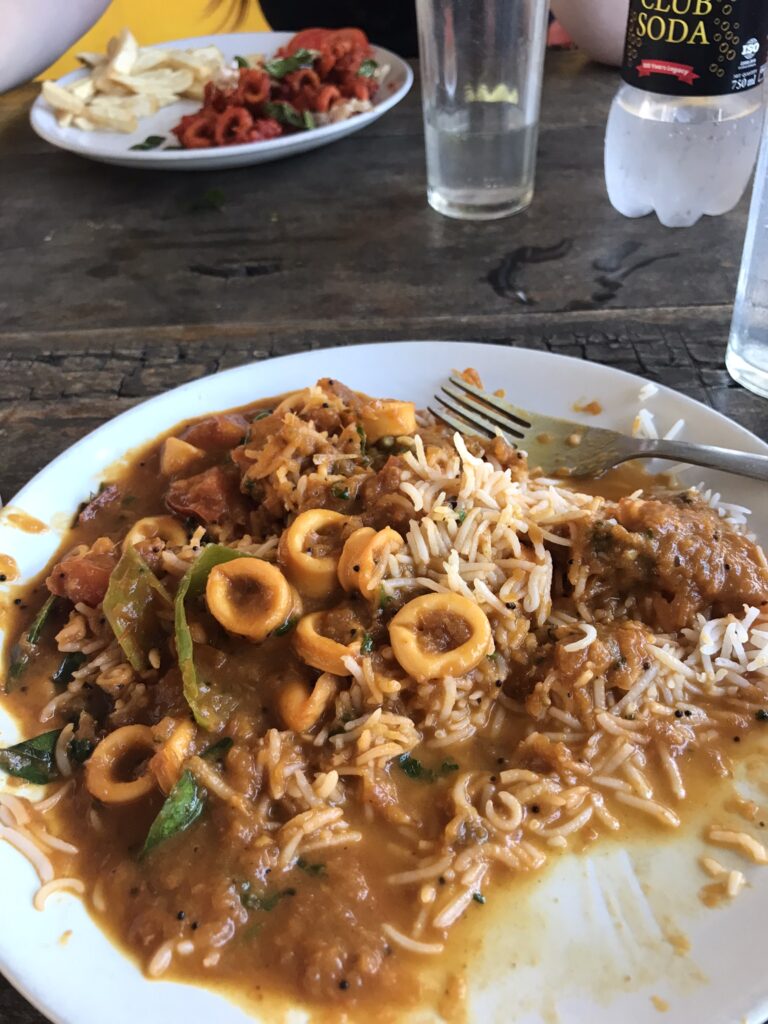
Tamil Nadu’s coast is a great place to try seafood curry
Tamil Nadu has a variety of landscapes, from coastal cities and beach resorts to the hill stations of the Western Ghats. In the centre of Tamil Nadu’s east coast, the former French colonial city of Puducherry stands separately. Puducherry did not join India until several years after the nation’s independence, and it is recognised as its own Union Territory which is not part of the state of Tamil Nadu. As it is surrounded on all sides by Tamil Nadu, I have included the city of Puducherry in this blog post anyway.
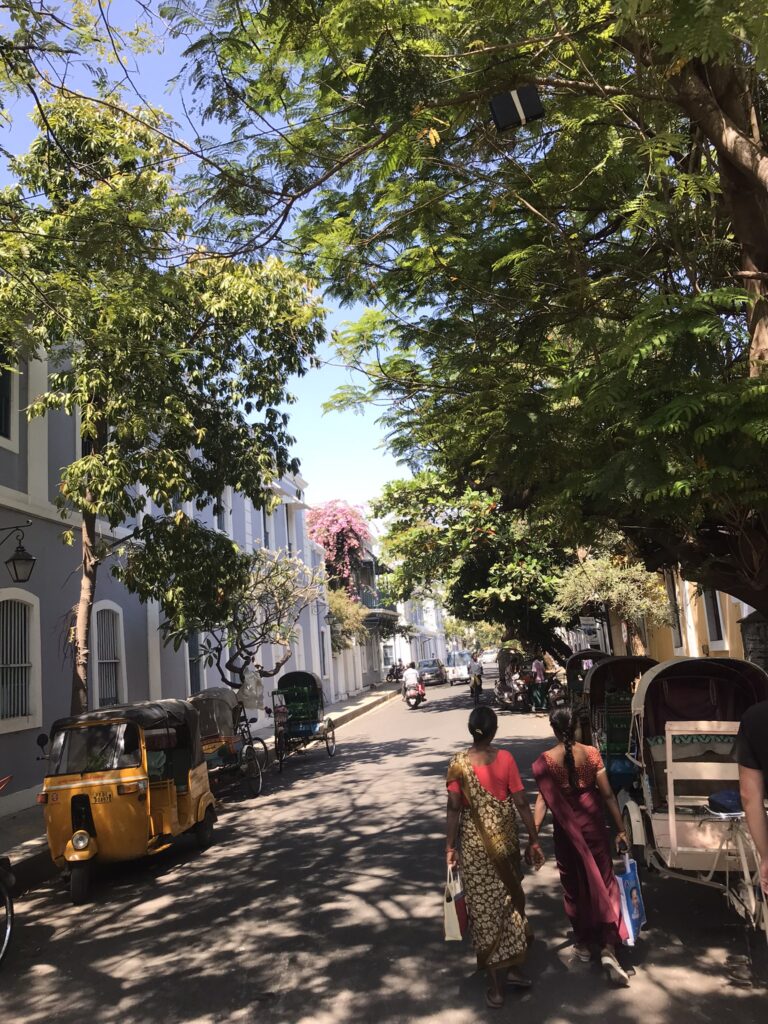
Puducherry, the former French territory, is not legally part of Tamil Nadu – it a Union Territory with its own governor and legislative assembly
Like every state in India, there is a lot to explore in Tamil Nadu. Culture and heritage lies at every turn and we were barely able to scratch the surface. Sadly we didn’t make it to Madurai or the Western Ghats, which would definitely be on our list if we had more time!
Chennai
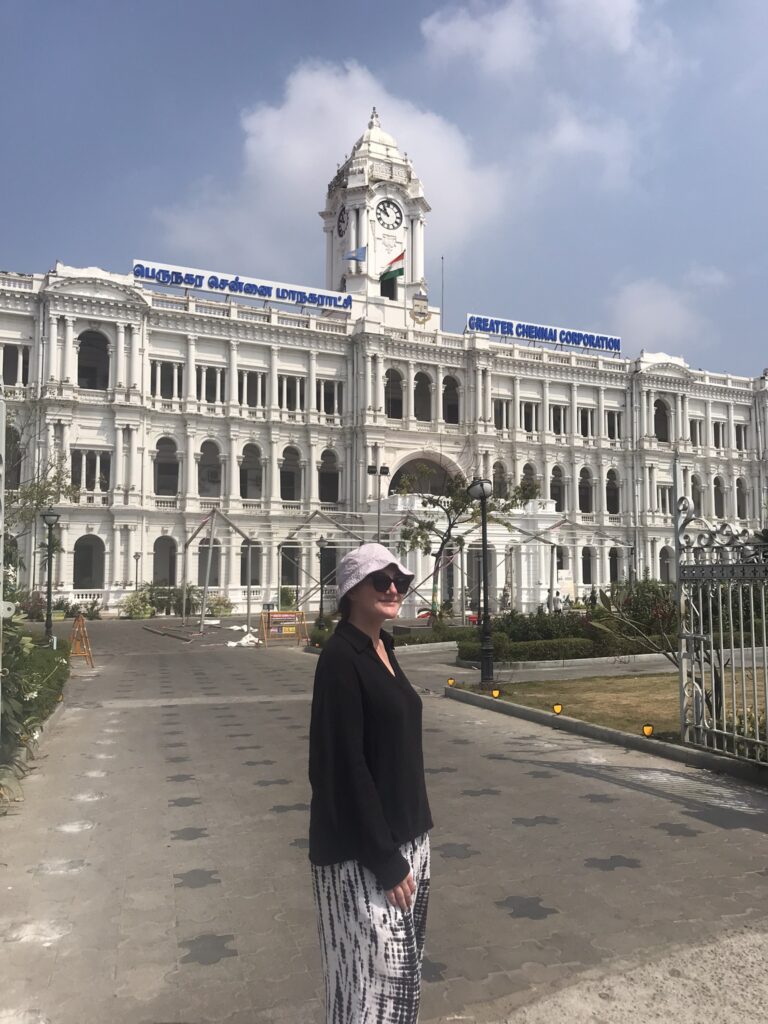
The largest city in Tamil Nadu and one of the largest in India, Chennai was formerly known as Madras. If you said Madras to most people from England they would think you were talking about a type of curry, however Madras is actually a very historically significant place. Although the British initially landed in Surat in the modern state of Gujarat, Madras was the first major fort and trading post of the British presence in India. The development of Fort St George in Madras can be considered to have played a key role in setting into motion the beginning of the British colonial rule in India, which changed the course of history in the nation.
After independence, Chennai became the capital of Tamil Nadu state – the name of the city was changed from Madras to Chennai in 1996. Modern-day Chennai is a sprawling metropolis and the second-largest city in the south of India after Bengaluru.
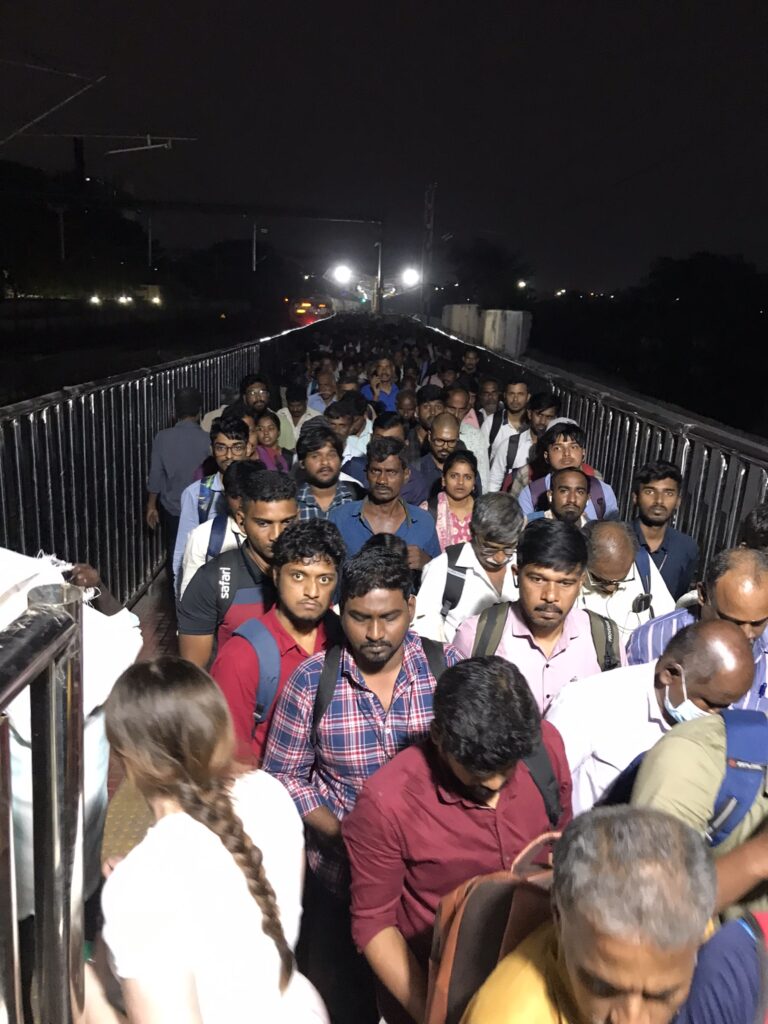
Chennai is a busy place but it didn’t feel chaotic or disarrayed compared to cities in the north
Chennai was the first city we visited in Southern India and we immediately noticed a distinct difference from the India we’d left in the north. Although it’s a huge city, things in Chennai were so much more laid-back, less full-on and intense than similar-sized cities in northern India. Not that there was no litter or it wasn’t busy, but comparatively it was much more manageable. We spent several days in Chennai and were not worn down or weary from noise, pollution and general nonsense like we were in the north.
We were also impressed by the standard of Western food in Chennai. This sounds counterintuitive as we usually like to eat local food, but after living off nothing but paneer in the north of India and struggling to find decent places to eat even in big cities it was a welcome change to have a variety of more familiar options. There were plenty of mid–range and higher-end restaurants and cafes in Chennai with tasty food and decent levels of hygiene.
A coastal city, Chennai is very hot and humid all year round. It was a struggle to walk around sometimes in the heat particularly in the middle of the day – we found that many places actually closed during the midday hours when the temperatures are at their peak. The city’s Marina Beach is one of the largest urban beaches in the world but Chennai isn’t really known as a beach destination – head south from Chennai along the East Coast Road if you want the beach. Chennai is more known for its history, grand colonial architecture and modern level of development as a major urban centre.

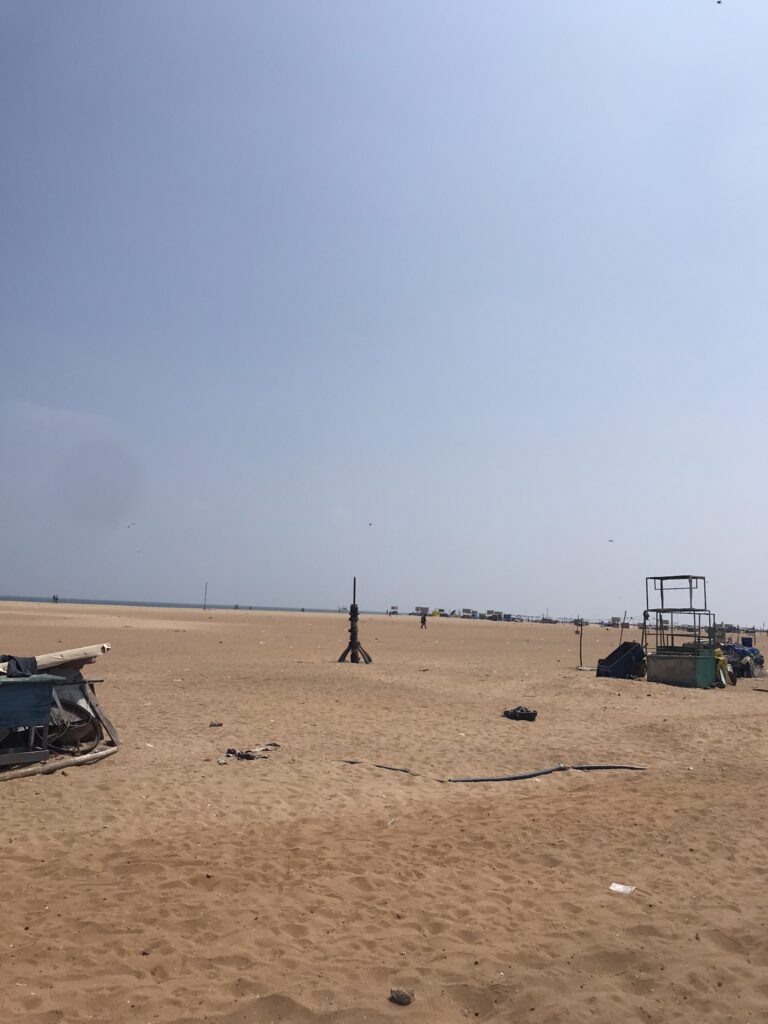
Marina beach is huge but a little strange – it’s almost too big
Chennai is also known as a major regional transport hub and gateway to the south of India, as well as an important transit point for Sri Lanka. The cheapest flights to and from Sri Lanka are usually from Chennai airport. It’s easy to access the airport from the city centre in Chennai using the Chennai metro.
Chennai metro has two lines, both running on roughly the same northeast-southwest axis parallel to each other. It can therefore sometimes be difficult to get to places in the middle of the two lines. Coverage is not great for many of the main tourist attractions, although the city does seem to be in the process of building additional metro lines which will help. Uber also doesn’t work particularly well in Chennai in our experience.
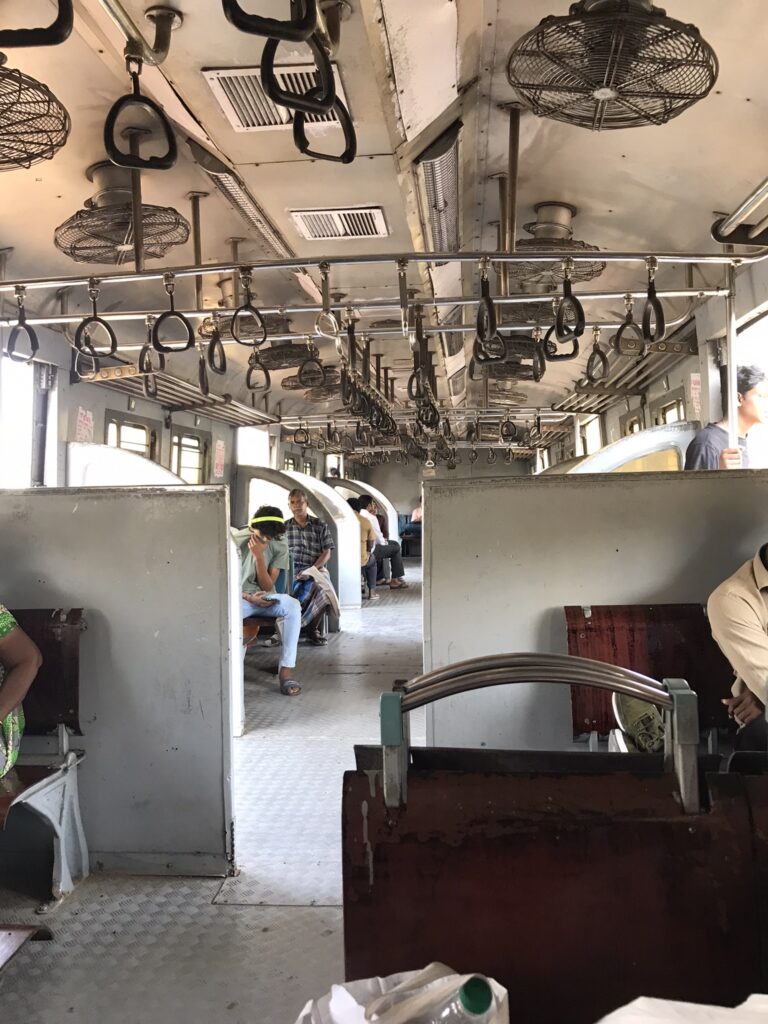
The local suburban trains are cheap and pretty spacious – combined with the metro you can just about get around
Chennai also has a local suburban railway line which covers many other parts of the city not reached by the metro, including Mylapore. The trains are extremely cheap and easy to use – just walk up to the counter at any station and buy a ticket, which is valid for a single journey. Trains are large, open-plan and not overcrowded most of the time. It is possible to ride hanging out of the door if you want to cool down. There is only one point where you can conveniently change between the Chennai metro and the local train line – you need to go to Central Metro station and then walk to Chennai Park rail station to change between the two.
Accommodation
Bright & Cozy Home @ Mylapore (Airbnb) – an apartment in a quiet residential block. With two bedrooms and bathrooms, it felt like a family apartment. We appreciated the fact that there was a washing machine here so we could do our laundry.
The Hydel Park – Business Class Hotel – a great location close to Egmore and Central rail stations and the Central Metro. It’s located down a back street filled with questionable-looking hotels, however we had a good experience at Hydel Park. The room was surprisingly clean and quiet and the reception guys went out of their way to give us a good service, to the point where they even sent a worker out to the shop to buy milk for us. One of the hotel ‘boys’ even carried Dan’s bags all the way to the Metro without asking for anything – we felt bad and gave him a tip.
Foodie Places
Writer’s Cafe – a variety of good quality Western food options. Very refreshing slushies and I was impressed by the range of cakes available – they even had the Russian honey cake that I got a taste for in Kazakhstan, and the quality was just as good. We ate in the cafe and also ordered from them on Zomato.
Bask, by coffee? – we never actually ate at this restaurant but ordered numerous times from Zomato and it became our go-to place in Chennai, their menu is quite extensive covering everything from sandwiches to pizza to Thai food, and everything we tried from here was great. The caprese sandwich (mozzarella, tomato and pesto) was probably in the top 3 sandwiches I have ever eaten.
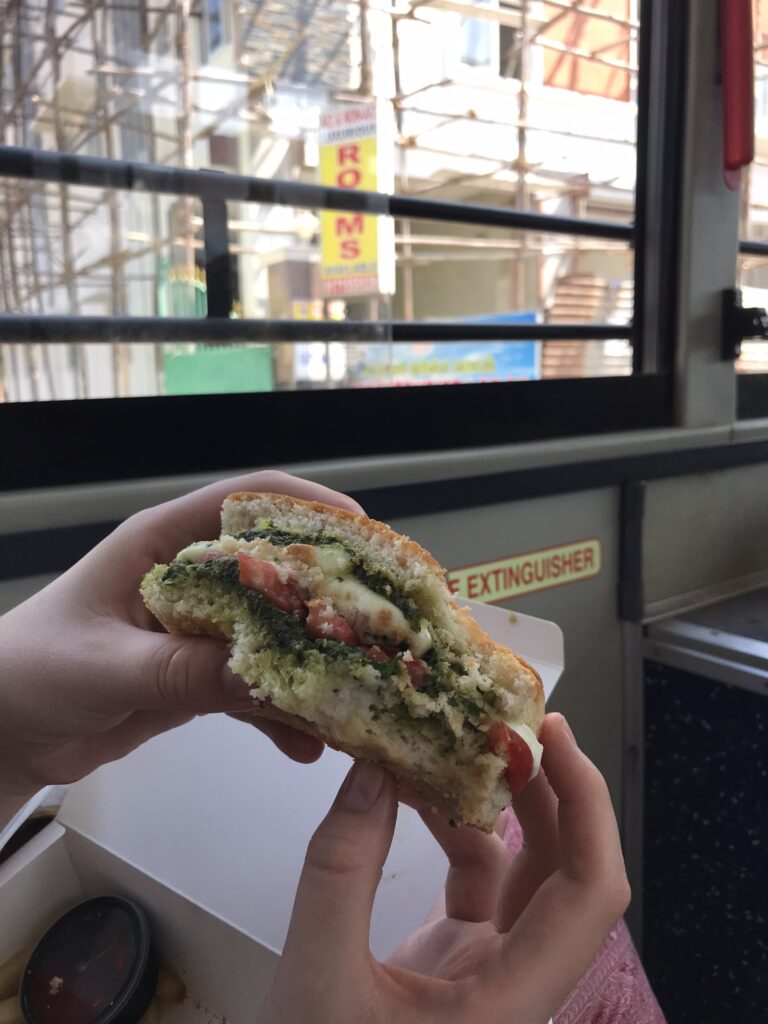
This sandwich was so, so good
Activities
Fort St George – a very significant building in the history of India as it was the first major British fort established in the land. The British colonial rule of India, as well as the city of Madras itself, can both be considered to have expanded outwards from this fort. Today the majority of the fort area is an active military base and administrative center which is heavily guarded and off-limits to visitors, but there is a small museum which is accessible to the public.
The fort is annoyingly difficult to reach by train. Public access to the museum area is from the east side, along Beach Road closest to the ocean. This means that from Chennai Fort station you need to walk around the entire circumference of the fort complex, which is not great in the heat. You have to go through a security check to even get onto the fort/base and access the museum, which is located in a historical building dating back to 1795.
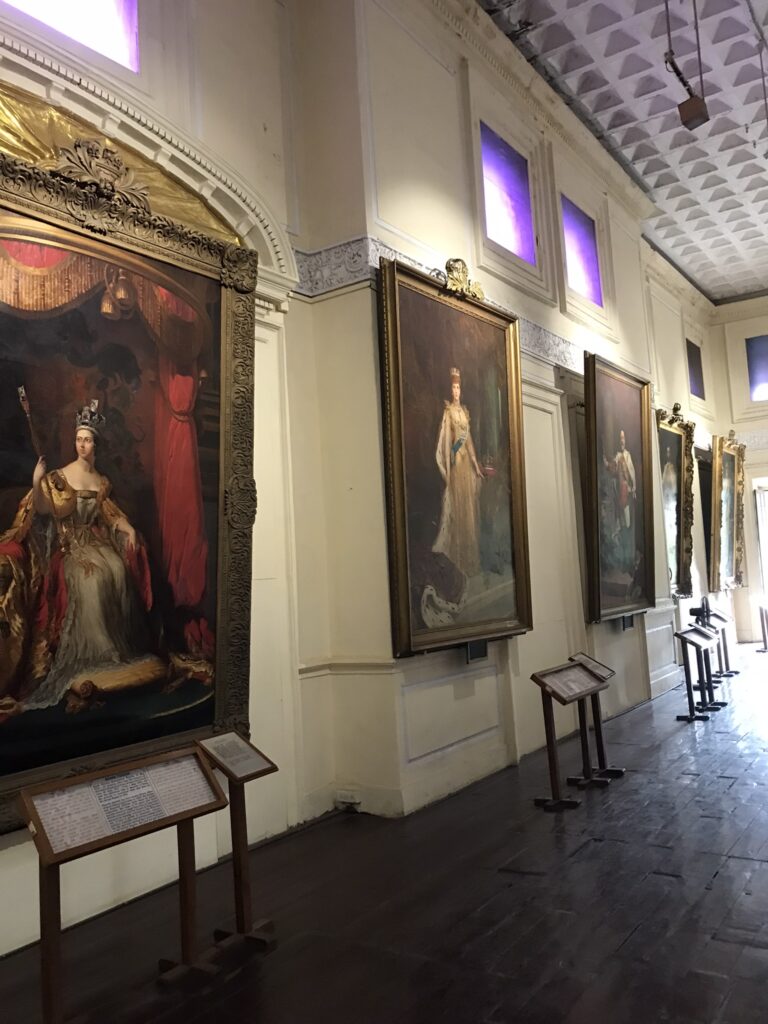
The gallery of colonial portraits inside the Fort St George Museum was particularly impressive
The museum has a lot of information about the early days of the British presence in India, the development of the city of Madras and the fort itself. There was a particularly interesting story about the initial construction of the fort, which was apparently arranged by two British officials without permission – the tale is told in the museum. There is also a portrait gallery featuring priceless artworks of British monarchs, viceroys and important colonial figures. The museum also houses one of the oldest flags of India, allegedly the first flown after the nation gained independence.
High Court – one of the grand historical buildings in the city, it’s a working court so we could only catch a glimpse from the roadside. Interestingly the court still bears the name Madras.
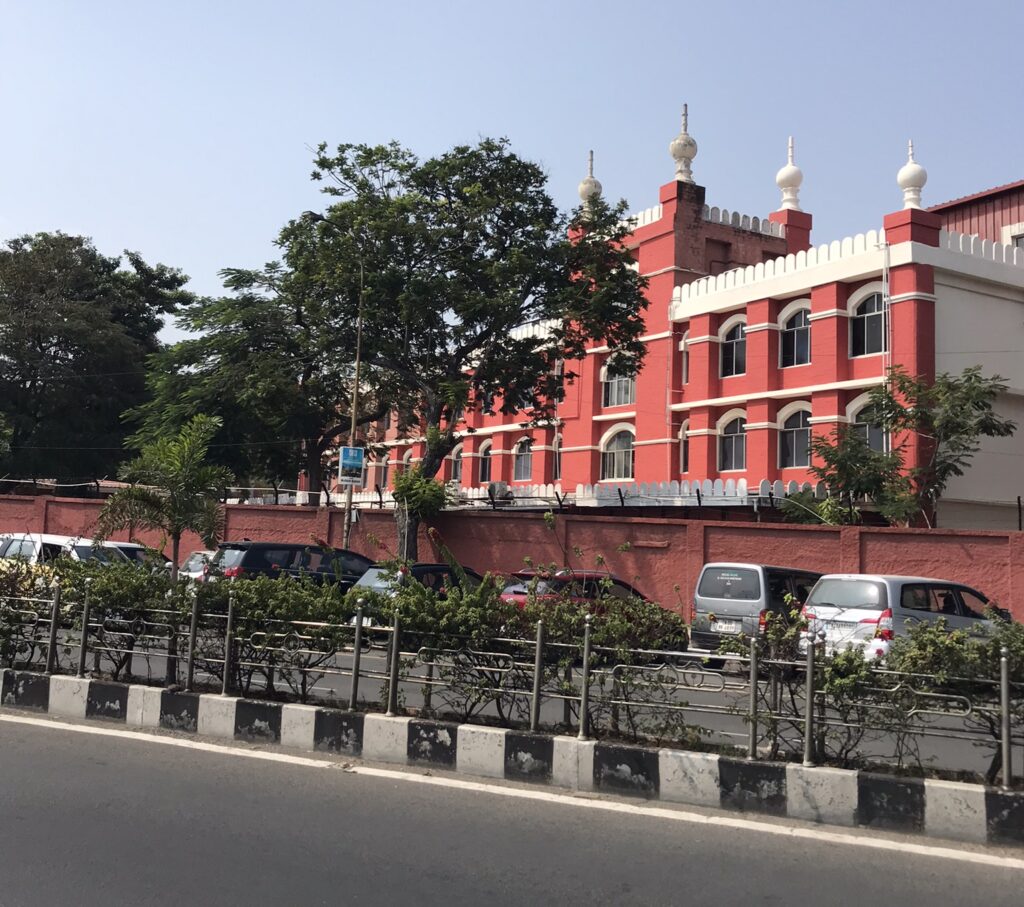
Unless you’re involved in a case, it’s pretty tricky to get a closer look at Madras High Court than the road
Government Museum – a strange place. The museum complex covers a huge sprawling area with many different buildings, some of which are open and have exhibits inside focusing on a single medium such as sculpture, bronze or painting. Other buildings seemed to be closed or being used for purposes unrelated to the museum. It reminded us of an old hospital or university campus.
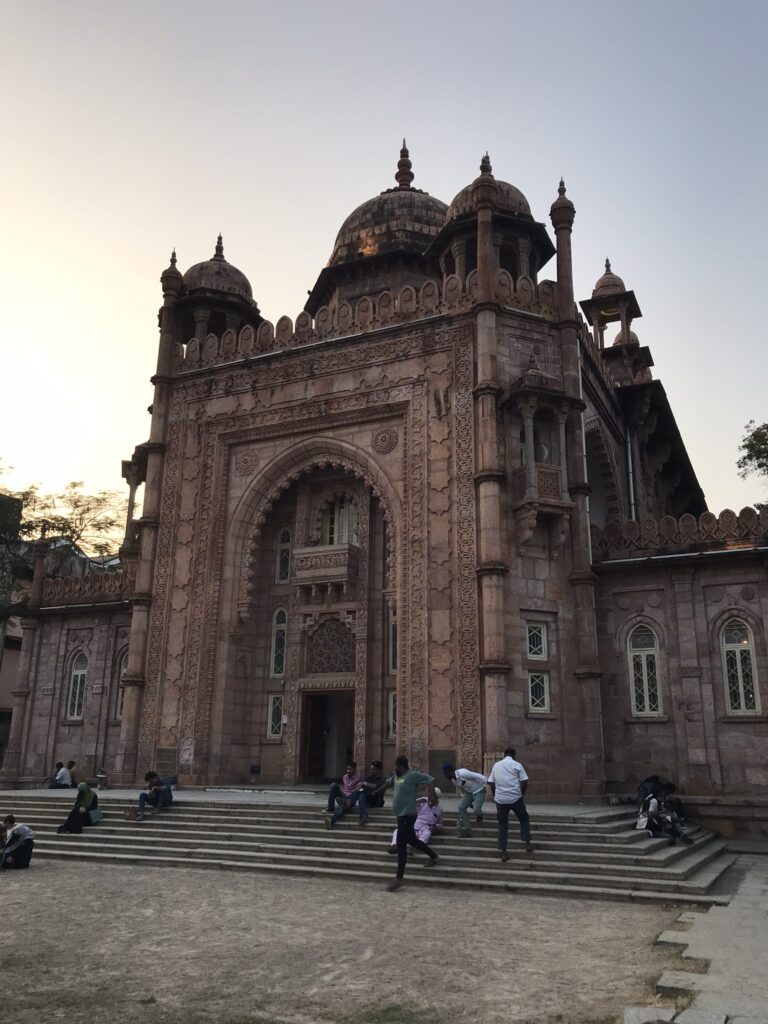
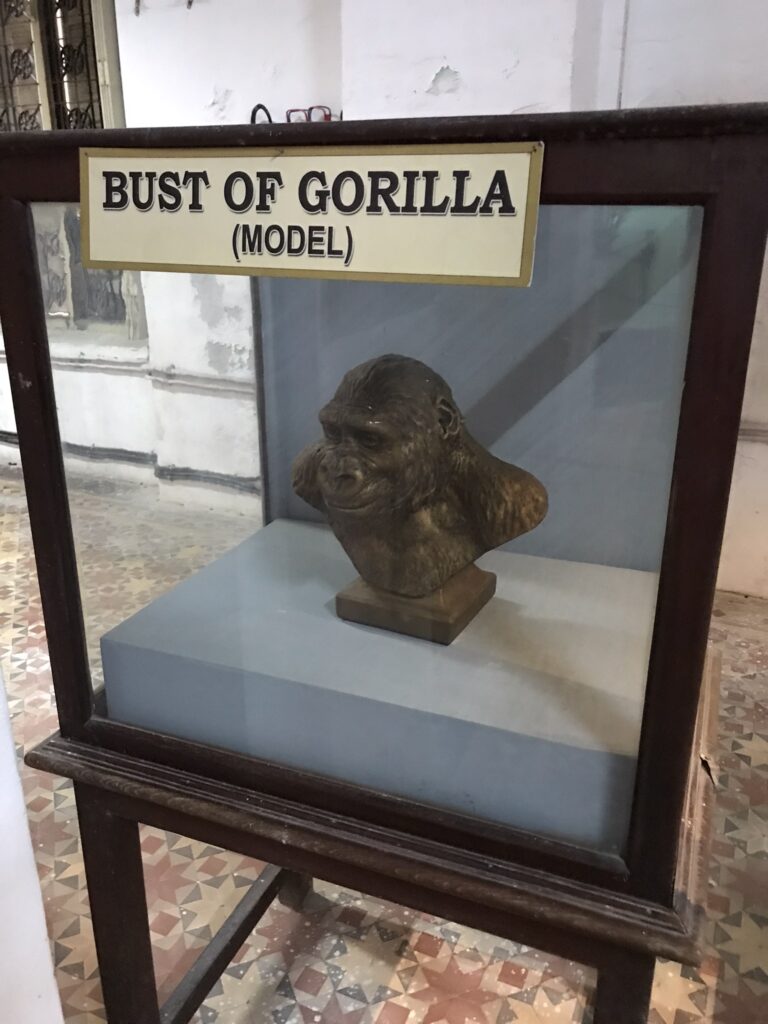
Some of the buildings in the Government Museum complex were quite interesting although it wasn’t always clear where the actual exhibitions were
We particularly enjoyed the art gallery, which contained British colonial portraits, Mughal miniatures and paintings from the Thanjavur and Mysore dynasties. As well as the art gallery, there is also a sculpture gallery with Hindu sculptures from various local dynasties, a bronze gallery with some very old and interesting Hindu and Jain bronzes, and a zoology section which we didn’t enter. The sculpture gallery was stuffy and in need of refreshing – not the greatest we’ve seen in India, although it at least displayed sculptures in chronological order and grouped by dynasty which made it easier to follow.
Santhome Cathedral Basilica – a large Catholic church and minor basilica which was initially built by Portuguese missionaries prior to the British occupation. It is famous as it was said to have been constructed on the original burial site of St Thomas, one of the disciples of Jesus more commonly known as ‘Doubting Thomas’. We had no idea that one of Jesus’ apostles was in India. Thomas was allegedly killed in Chennai by a jealous Hindu priest. The spear that killed Thomas is on display in the attached museum along with other relics related to Thomas and other saints. The museum also contains the tomb of Thomas.

Supposedly this is the spearhead that killed Doubting Thomas
Chennai Lighthouse – you can take an electric lift up the lighthouse to get great views over Chennai beach and the sprawling cityscape. This is actually the fourth Chennai lighthouse. The viewing platform at the top is covered by a metal grate so it isn’t a great place for selfies. There is an info plaque with information about the history of the lighthouse.
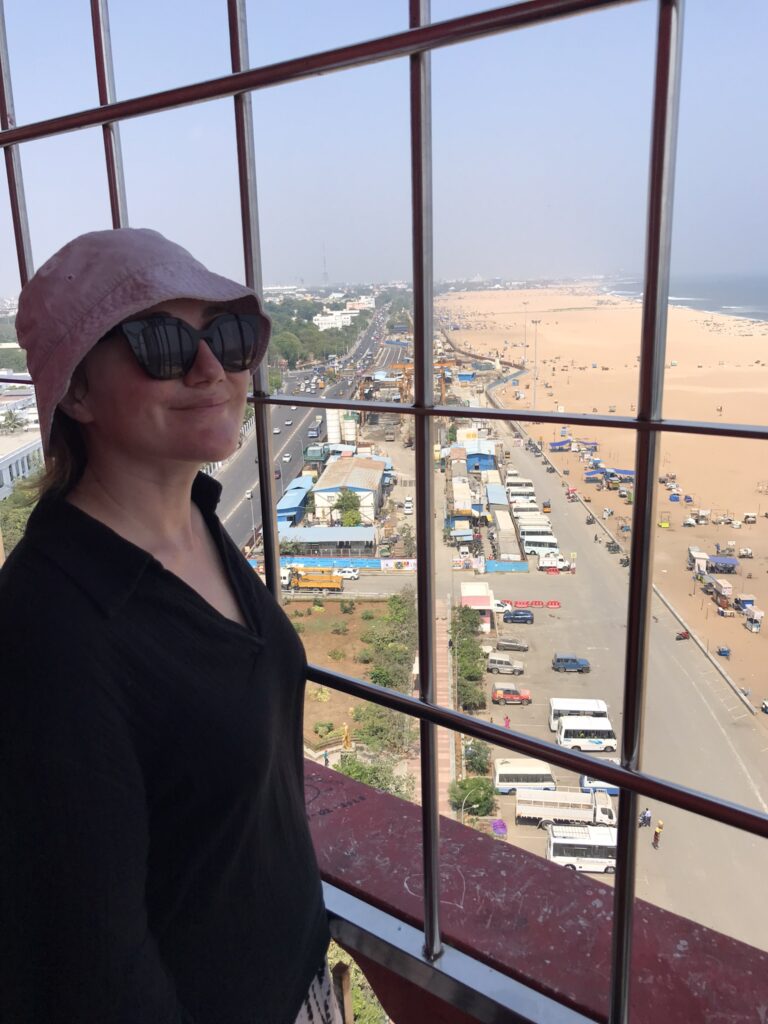
A grate view
Marina Beach – one of the largest city beaches in the world. We walked along the beach at midday and came across lots of closed street food vendors that looked semi-abandoned – maybe they open at weekends? The beach was a little messy but nothing like Chowpatty in Mumbai. However it was also quite a desolate place – it was so large that it almost felt like being in a desert more than the beach. Swimming is not permitted here, if you can even make it near to the sea.
Parthasarathy Temple – a large, typically colourful southern Indian Hindu temple. Unfortunately the temple is closed between midday and 4pm so we could only look from the outside. A crazy cow in the vicinity of the temple was causing a ruckus and threatened us too as we went past – usually urban cows in India are very docile, but this one wasn’t!
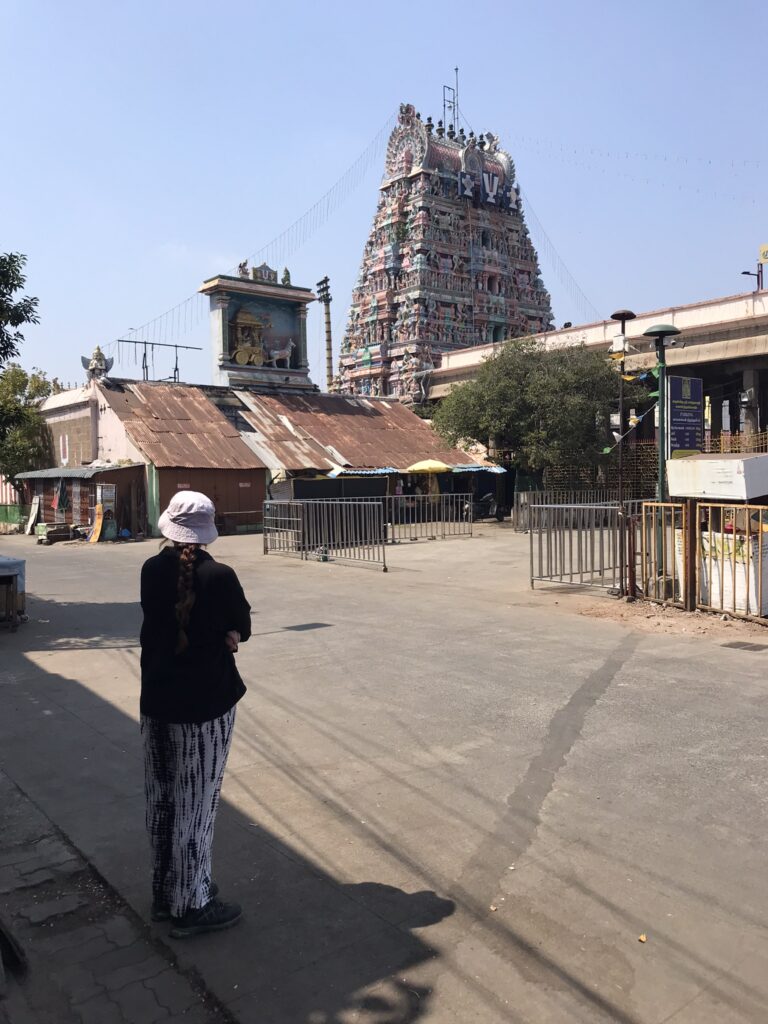
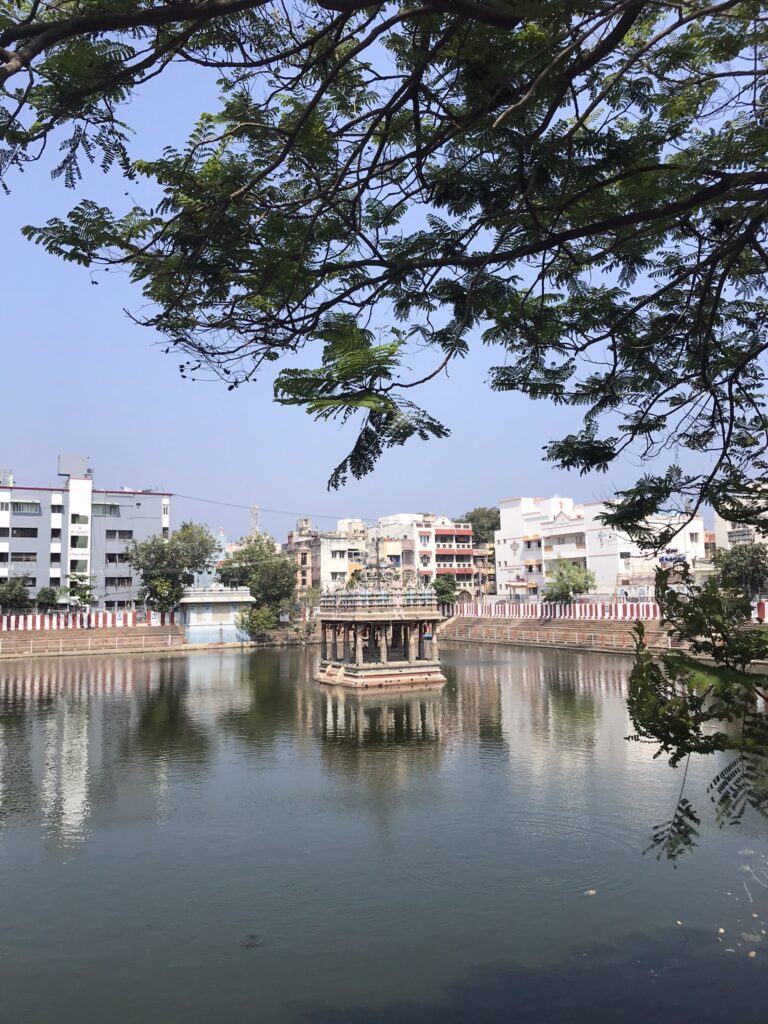
Parthasarathy Temple – a classic Dravidian temple
Check out my self-guided tour of Chennai’s waterfront area – click here!
Mahabalipuram
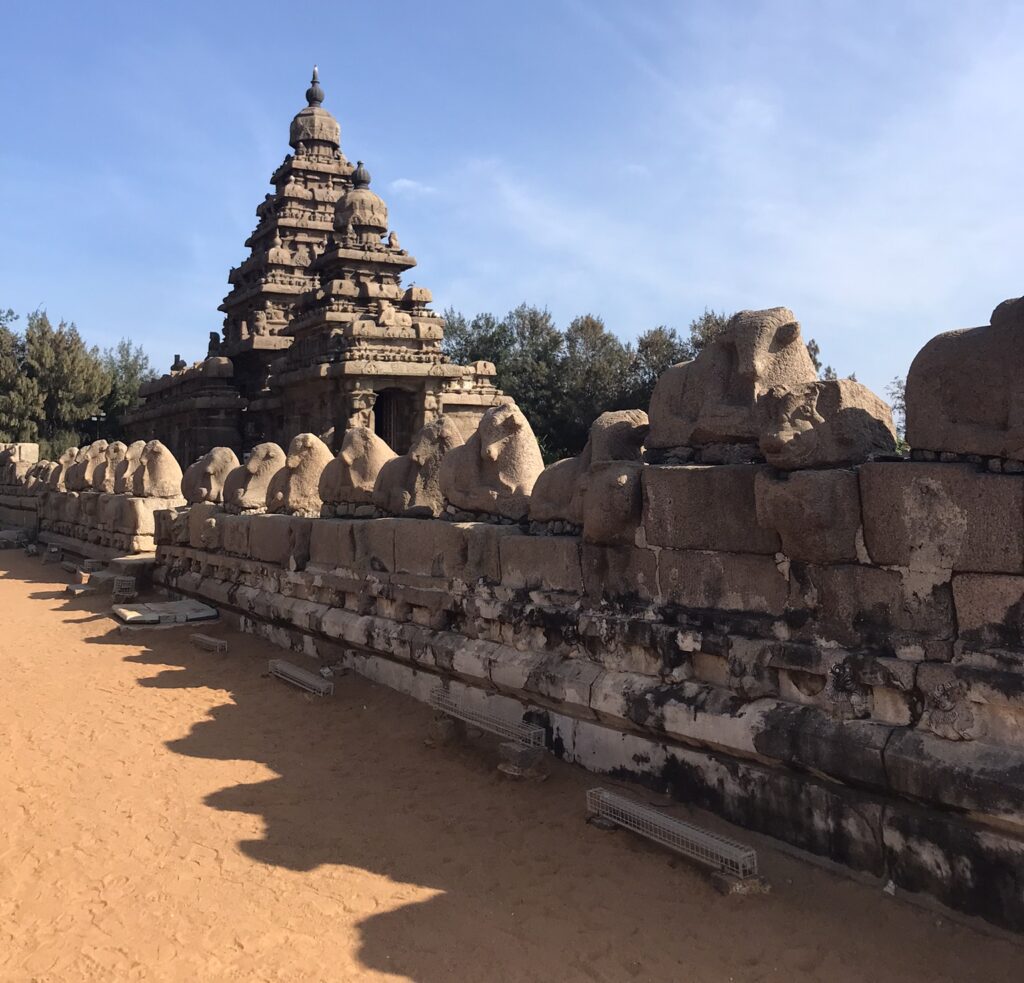
Located along the Coastal Road south of Chennai, Mahabalipuram is best known for its ancient Hindu rock temples and carvings. Dating from the 7th and 8th century, the temples are protected as a UNESCO World Heritage Site and are considered to be among the most important and impressive archaeological sites in the south of India.
Mahabalipuram itself is a small and intimate-feeling settlement, with brightly-coloured shrines and larger colourful South Indian-style temples dotted throughout the town. The ancient temples, created by the Pallava dynasty, are clearly the biggest draw for visitors – they stand out for both their age and intricate designs. There are three main complexes around Mahabalipuram – the shore temple, the five rathas complex and the cave temples. All can be visited very easily on foot in a day – Mahabalipurm is not a big place at all.
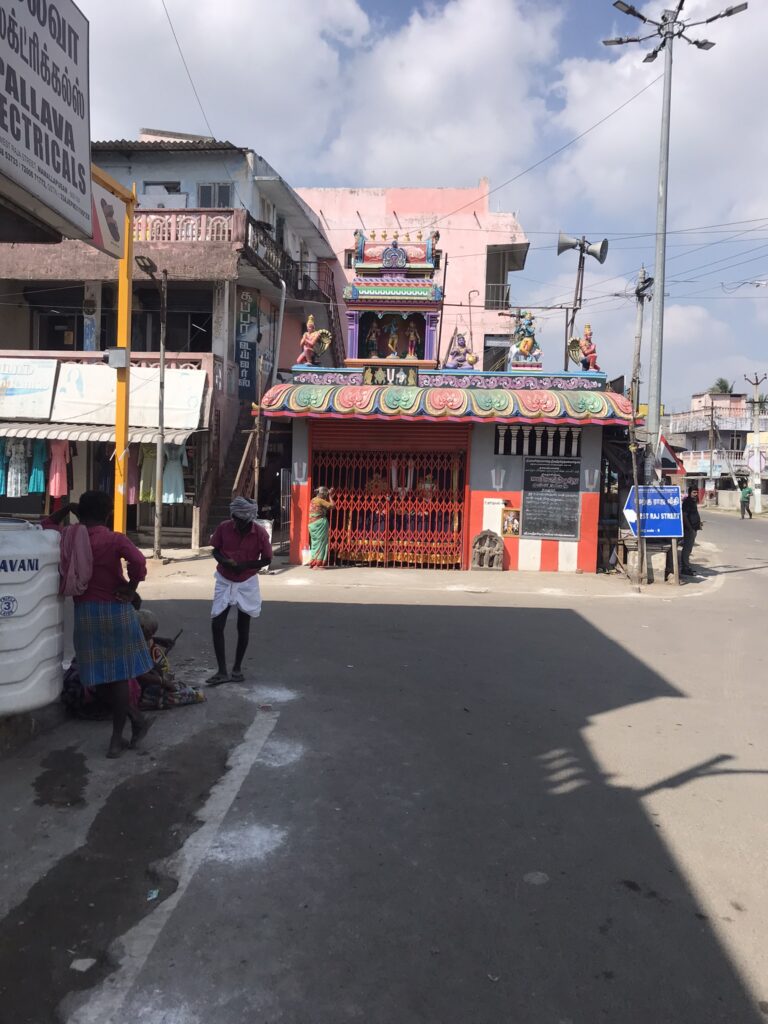
Plenty of colourful Hindu shrines can be found around the quiet streets
As well as its temples and history, Mahabalipuram is a nice beachfront location. It’s a more laid-back place and away from the temples it felt more like a hippie beach town, with a main strip road lined with tourist shops and seafood restaurants. The many touristic clothing shops on the strip seemed like a carbon copy of one another – typical floaty white linen and tye-dye hippie stuff. There is also a book exchange shop, which is handy if you’re on the road for months at a time like me and run out of reading material.
The local economy is based on fishing, you can see the rustic fishing boats and grizzled fishermen on the beach. The seafood in the local restaurants is the best we had in the Indian subcontinent – a must try for visitors. We rolled our eyes when we saw a white tourist in a restaurant ordering paneer butter masala – don’t do this!
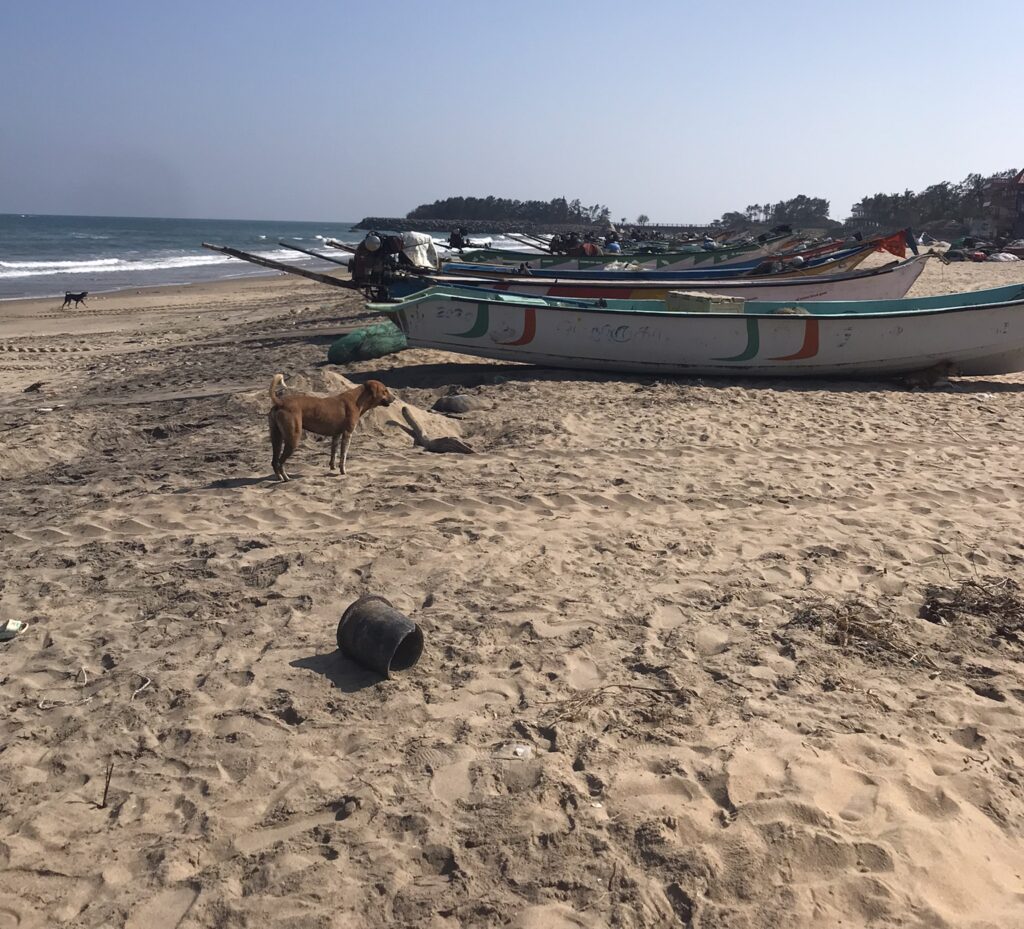
Most locals are either involved in tourism or fishing
Mahabalipuram is easily reached from Chennai via the East Coast Road. Bus 588 from Thiruvanmiyur bus station in Chennai to Mahabalipuram cost less than 50 rupees and buses depart very regularly. It’s a really scenic route along the East Coast Road with a few small towns, nice-looking settlements and beachside developments along the way. Some of these seemed more like gated communities.
Accommodation
Blue Moon Guesthouse – along a quiet street which is very close to the beach and within easy walking distance of the main strip. Rooms were clean and modern with good AC (which is much needed in Tamil Nadu). Breakfast on the upstairs balcony was a treat in the morning, with great views across to the beach.
Foodie Places
Taaco’s Seafood Restaurant – an intimate dinner setting with only a few tables. We loved the fish curry and calamari. The restaurant also had a good playlist of alternative rock which we appreciated.
Gecko Cafe – our favourite seafood place in Mahabalipuram, this cafe is also located along the main strip. The owner was friendly and flexible, allowing us to try different dishes tailored to our budget and tastes. The restaurant has its own fishing boat and the owner is eager to bring out the fish of the day to allow patrons to choose their own. Dan enjoyed the calamari curry and we went on to treat ourselves to a platter of fresh curried fish. We also appreciated the relaxing music which was played in the restaurant, strangely consisting of Buddhist mantras.
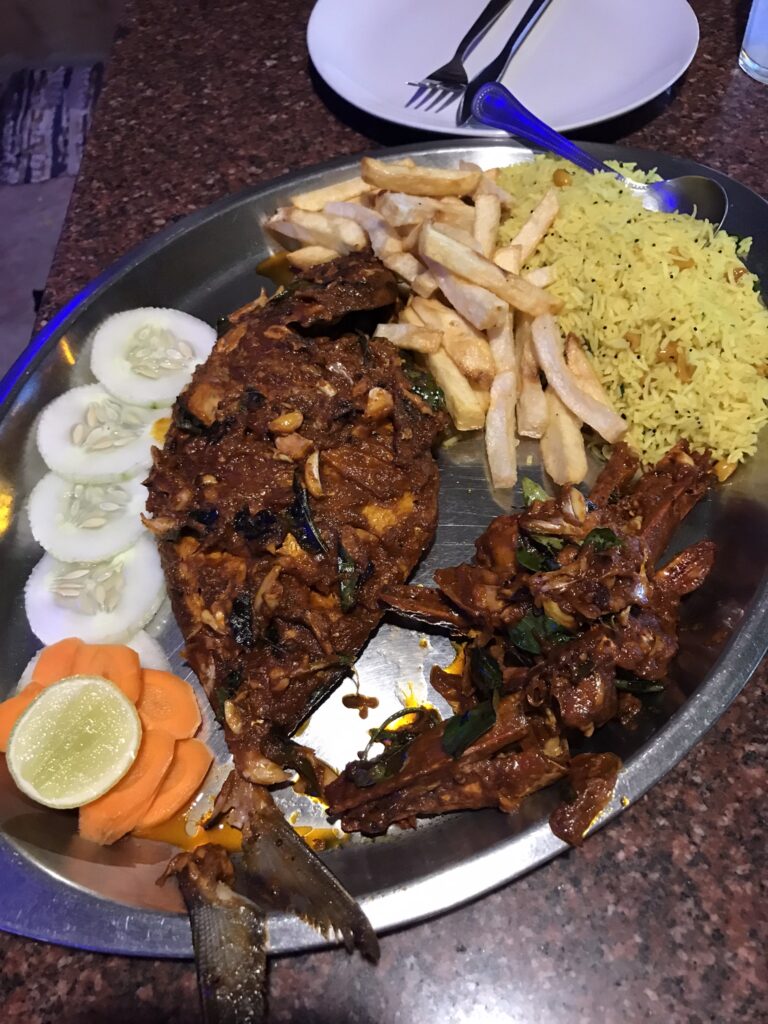
Curried fish is well worth a try – the owner at Gecko can tailor to your budget
Activities
Cave temple complex – the largest of the three Mahabalipuram temple complexes, featuring many different shrines and cave temples which have been carved into the rock. One of the major features is ‘Krishna’s Butterball’, a large circular rock which is precariously perched on a slope in a way that seems to defy gravity. The butterball is a popular spot for novelty photos – Narendra Modi and Xi Jinping took one such infamous photo together here in 2019.

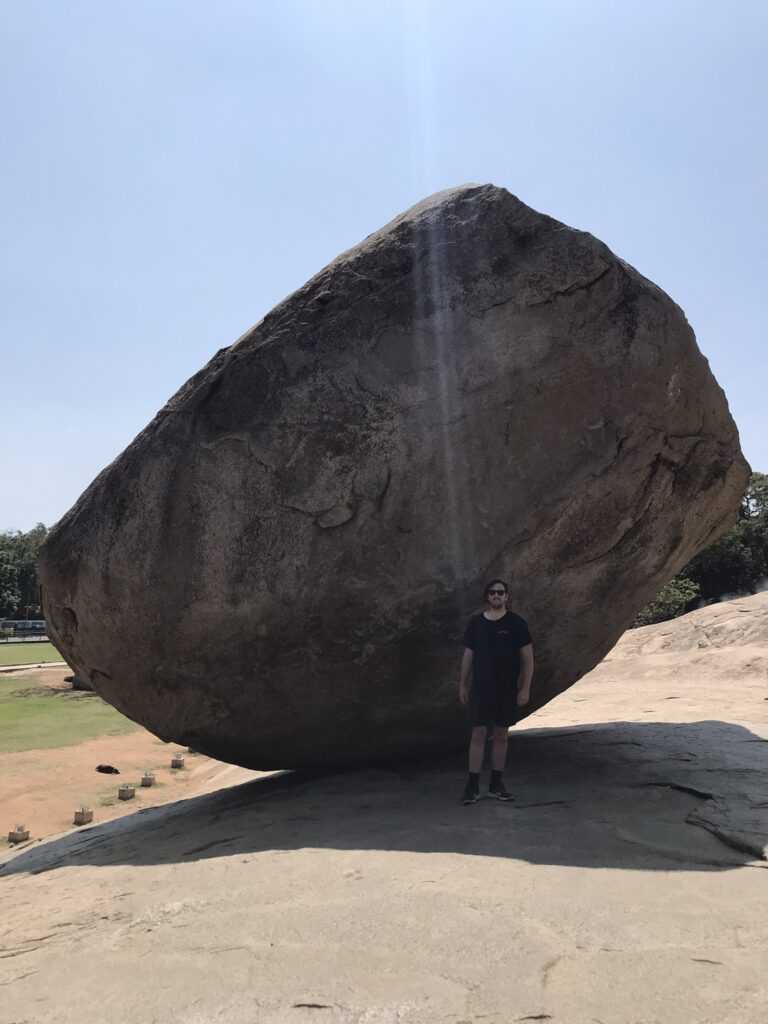
The complex is full of intricately-carved cave temples to explore as well as the famous butterball
Considering their level of decoration and preservation, the age of the rock temples is mind-blowing. Some of them are over 1,300 years old and contain such intricate details. This is a major part of the UNESCO complex, entry is paid and the area is well maintained with caretakers visibly preening the lawns and bushes inside.
Probably the most impressive feature of the complex is ‘Arjuna’s Penance’, a very large wall carving featuring an unbelievably intricate depiction of a Hindu mythological scene. Strangely, this is actually best viewed from the main road outside of the complex – we tried to view it from inside the complex and were stopped by a guard. There are some other smaller carvings and monuments along the road leading to the Five Rathas complex, as well as a lighthouse.
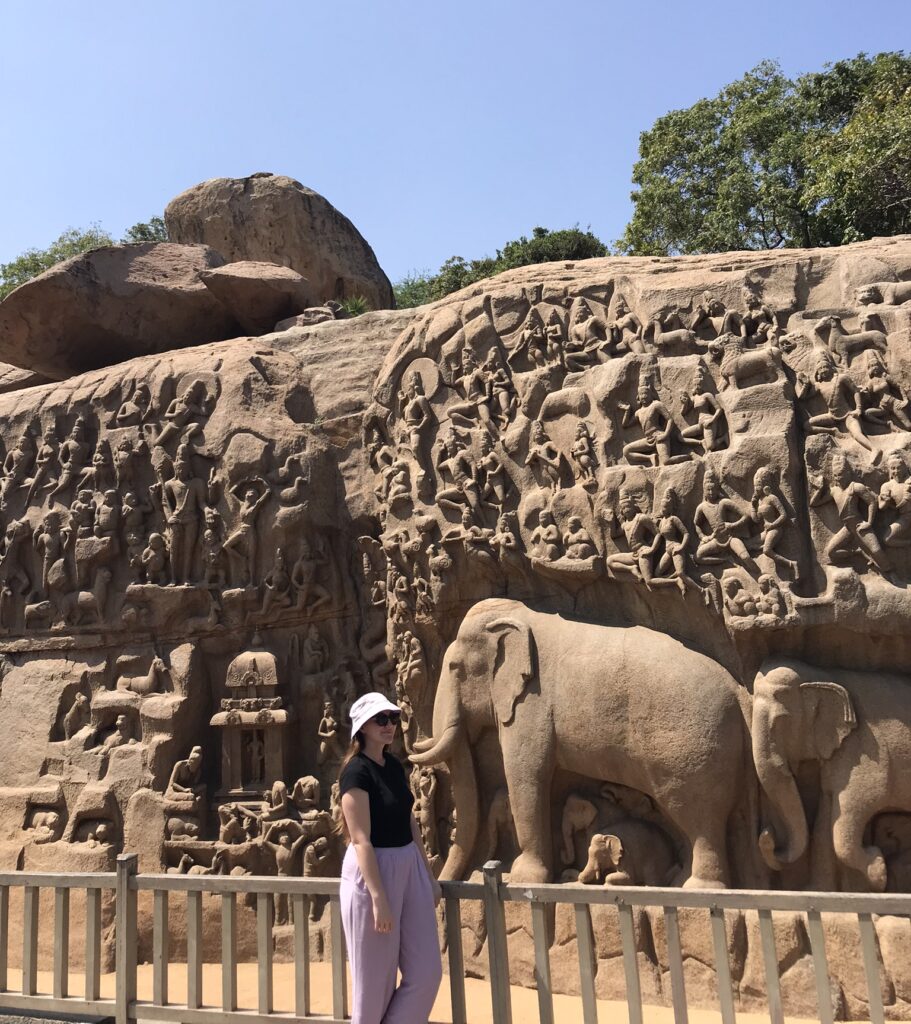
The scale of Arjuna’s Penance is mind-blowing
Five Rathas – another complex which comprises part of the UNESCO World Heritage Site. This complex features freestanding structures known as ‘rathas’ which are said to represent flying chariots. Unbelievably, these structures are 1,400 years old, dating from the 7th century. The rathas in the complex are different shapes and sizes, each with depictions of different deities and stories. Interestingly these structures were never completed and therefore were not used as temples – they have never actually served a religious purpose. Again, the carving work is exceptionally intricate. Unfortunately the complex was overrun by a group of local schoolchildren on a school trip when we were there.
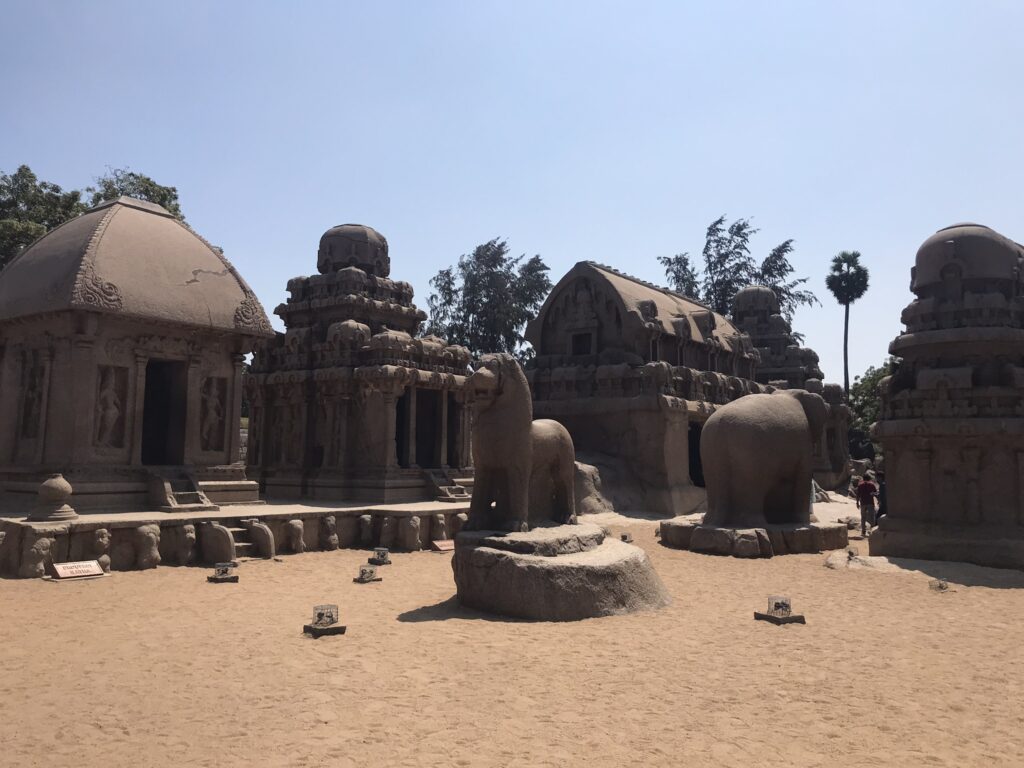
The Five Rathas complex is definitely worth the short walk from the town centre
Shore Temple – located along the shoreline and visible from the beach, this is the third part of the UNESCO site. The complex contains a single freestanding temple which is probably the largest and most famous of the Mahabalipuram temples. Some of the details were a little more eroded than the other temples, which is understandable given its close proximity to the sea. It’s still a mind-boggling example of craftsmanship from so long ago.

The shore temple is the most impressive singular temple in Mahabalipuram
The beach – Mahabalipuram boasts a long beach with a nice warm sea. Sadly the beach is not pristine as there is a fair amount of rubbish around, however the stretch outside the Radisson Blu hotel is regularly cleaned so probably makes the nicest spot that is easily accessible from the town. It’s obvious that the hotel maintains this stretch of beach for their paying guests, but I don’t think it is a private area – we chose to relax here twice and nobody stopped us.
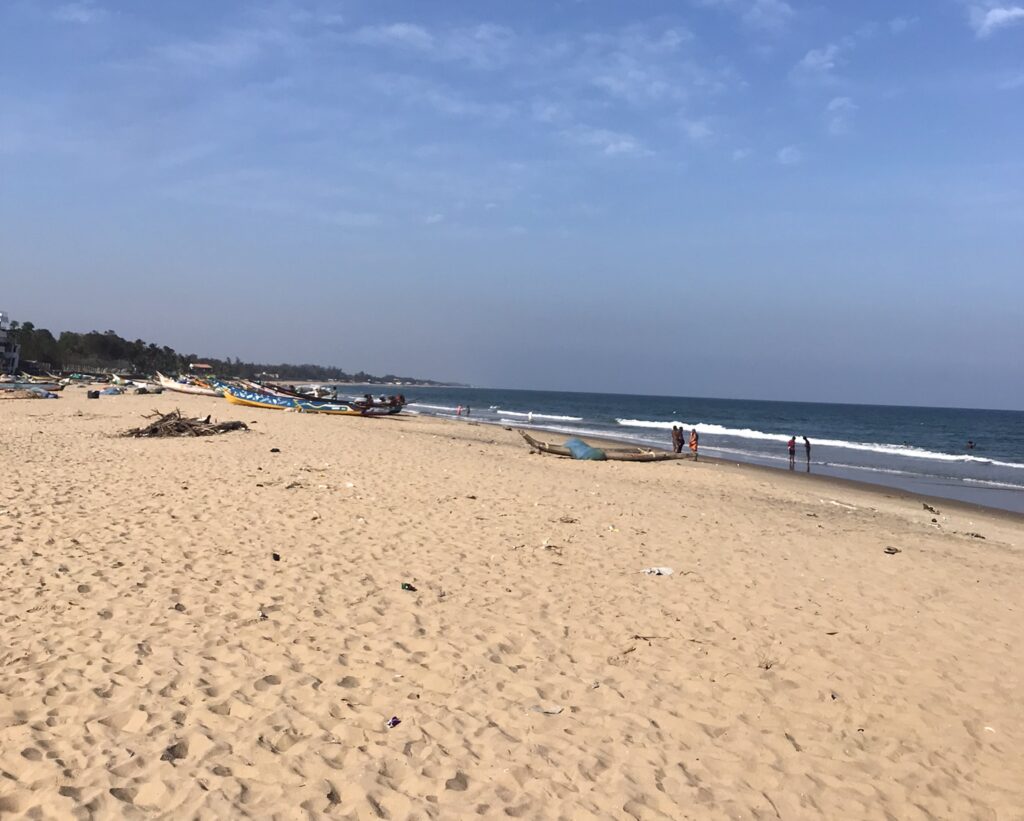
The beach is pretty extensive – it’s not spotless but I’ve seen much worse in India
There are a couple of hustlers and hasslers drifting around the beach trying to sell their various wares. They weren’t too persistent with us but did seem to follow some people, particularly the wealthy guests from the Radisson Blu hotel. The beach seemed safe enough, there were occasional Western female tourists on the beach in bikinis while we were there and nobody seemed to have any trouble or receive unwanted attention.
Puducherry
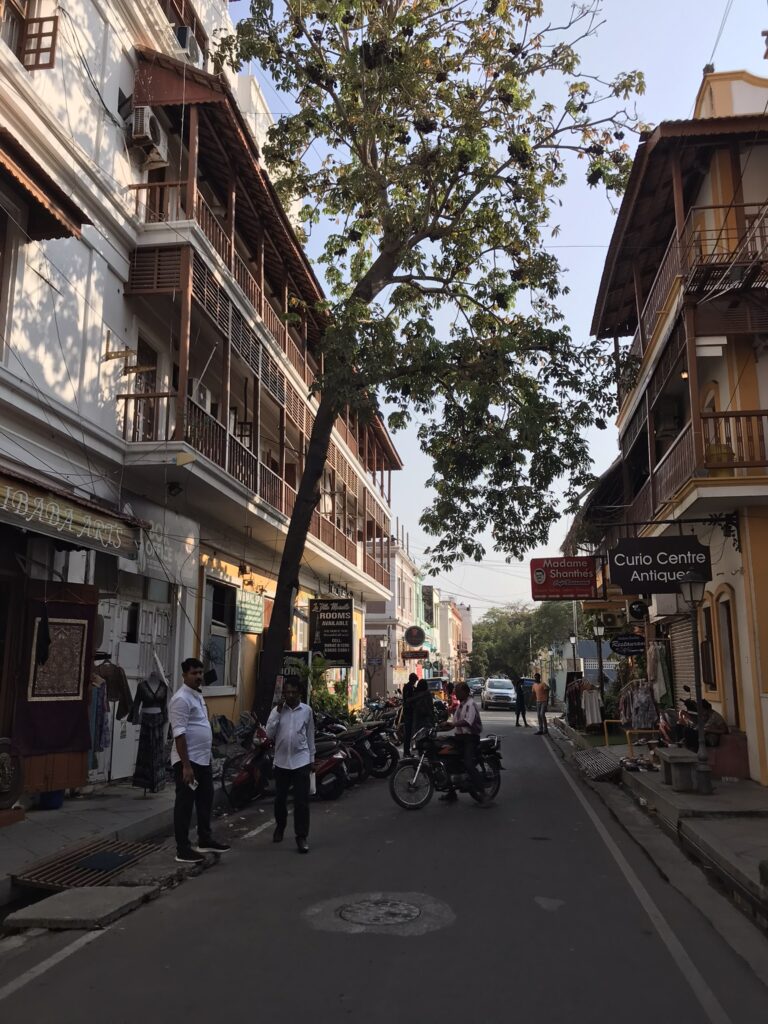
Puducherry, sometimes called Pondicherry (or Pondy for short), is somewhat unique in that it is a former French rather than British colony. When the rest of India gained independence from Britain in 1947, Puducherry remained under control of the French, only joining India in 1954. Following their union with India, Puducherry and the three other disparate small French Indian colonial settlements around the coast (Karikal, Yanaon and Mahe) were designated as their own Union Territory. For this reason, Puducherry is not officially part of Tamil Nadu – it is the capital of the Union Territory of Puducherry.
Understandably, there is a heavy French influence in Puducherry. Some locals still speak French, and have a French accent when they speak English. We even saw a few French expats working in cafes and bakeries. Streets have names like Rue Francois Martin and Rue de L’Evêché. There are many French quirks, such as the French World War 1 memorial and a park with a large statue of Joan of Arc.

Many of the streets in the White Town area have French names
The city has a proliferation of French cafes and patisseries serving classic French fayre such as fresh baguettes, croissants and quiches. Puducherry can be considered one of the top destinations in India for non-Indian food. Unlike in many other Indian cities, there is also a prevalence of beef on the menu in many establishments.
Puducherry was the subject of numerous conflicts during the colonial era and changed hands between the British and French several times. Not many important historical buildings remain in their original state, as many were destroyed by the British during their colonial clashes with the French. The site of the old French fort, Fort Saint Louis, is now Bharathi Park and few remnants of the fort can be found. However you can still see the old governor’s house (Raj Niwas), an iridescent white palatial building, as well as a number of grandiose colonial-era churches and cathedrals dotted around the French quarter.
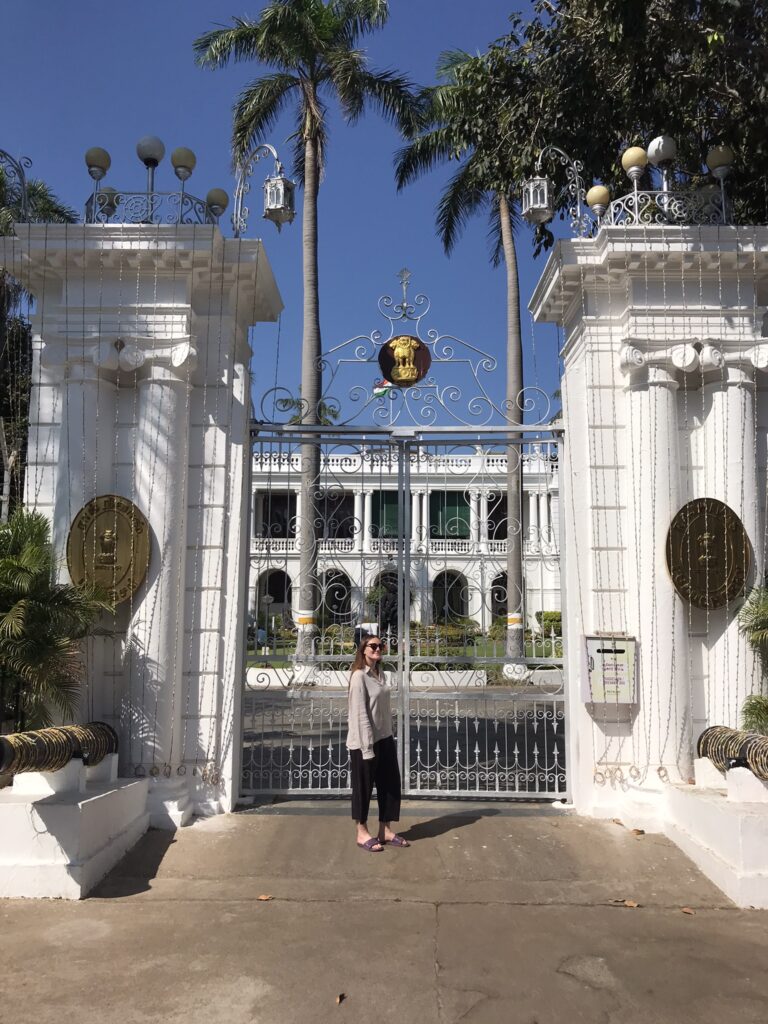
Raj Niwas is one of the few grand French colonial buildings remaining – it is now the official residence of the Governor of the Union Territory of Puducherry
Most of the French influence is centred around the French quarter, known as ‘White Town’. This is the main tourist area, home to a few blocks of streets lined with pretty colonial buildings and French-style cafes. The nearby promenade along the Bay of Bengal is a focal point for visitors and a top sunset spot, filled with benches and good places to sit. Although it’s a coastal destination Puducherry does not have a beach, just a rocky coastline which is most definitely not suitable for swimming. There is a popular sandy beach just south of town, known as Paradise Beach.
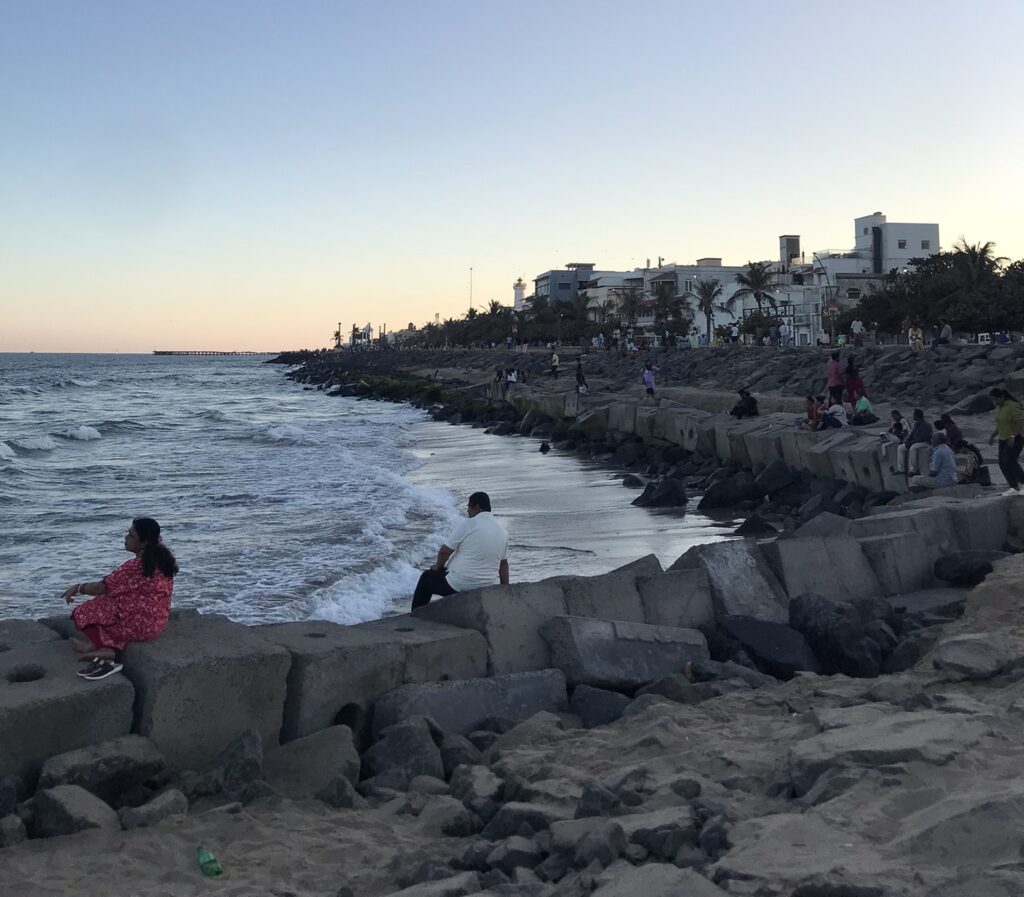
Puducherry’s beach is a rock beach – you’ll need to go out of town for sand and swimming
Puducherry is very popular with international tourists – particularly French – and also domestic tourists. We saw lots of cosmopolitan Indian visitors from other states dressed up in their best clothes having impromptu photoshoots among the colonial buildings, posing in doorways and among flowers in the street. There were plenty of Indian female tourists walking around in shorts and sundresses and it definitely felt like a tourism hotspot.
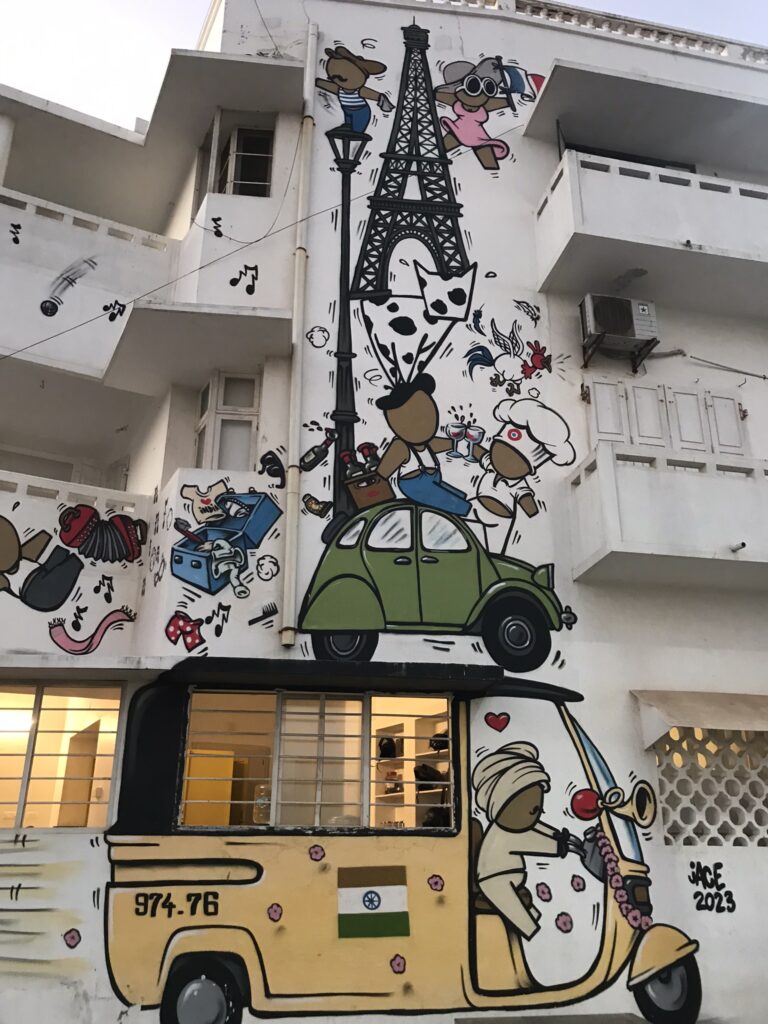
This basically sums it up
While there is a French colonial charm about the buildings which is mainly concentrated around the waterfront and White Town, we found that there was still a very Indian feel to the city. Think overcrowded chaotic streets with people speeding around on motos and sounding horns needlessly. Puducherry seemed to be suffering from an over-saturation of motos; there seemed to be more bikes here than just about anywhere else we visited in India (which is saying a lot), making it difficult to walk around sometimes.
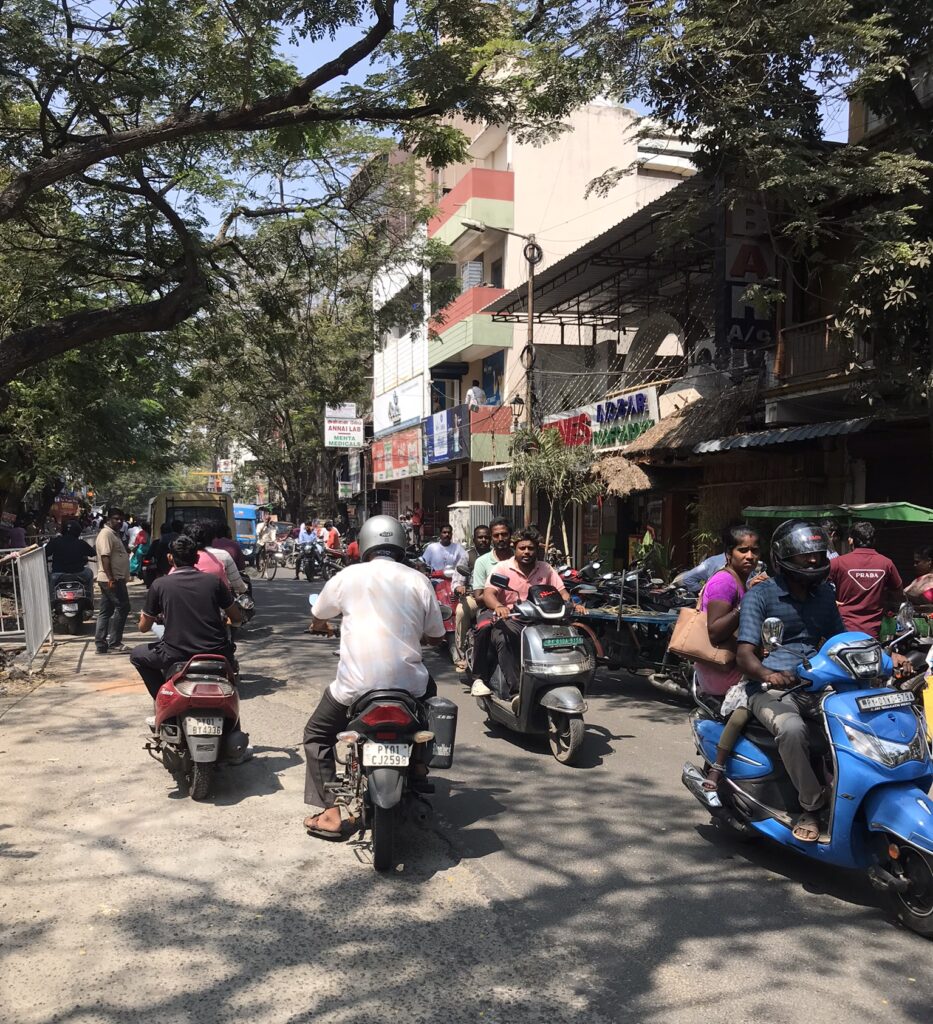
Moped mania – there are way too many in Pondicherry
Moped hire to domestic tourists creates overcrowding and poor driving on the roads, and some visitors seemed to miss the point of walking through the quaint streets. It ruined the French colonial vibe a bit when out-of-state domestic tourists would occasionally come flying through the White Town backstreets on loud motos, obnoxiously blaring their horn for no particular reason. Parking also seemed to be an issue for the mopeds. Outside of the French quarter and waterfront, Puducherry from what we saw just seemed to be a fairly normal, busy Indian city.
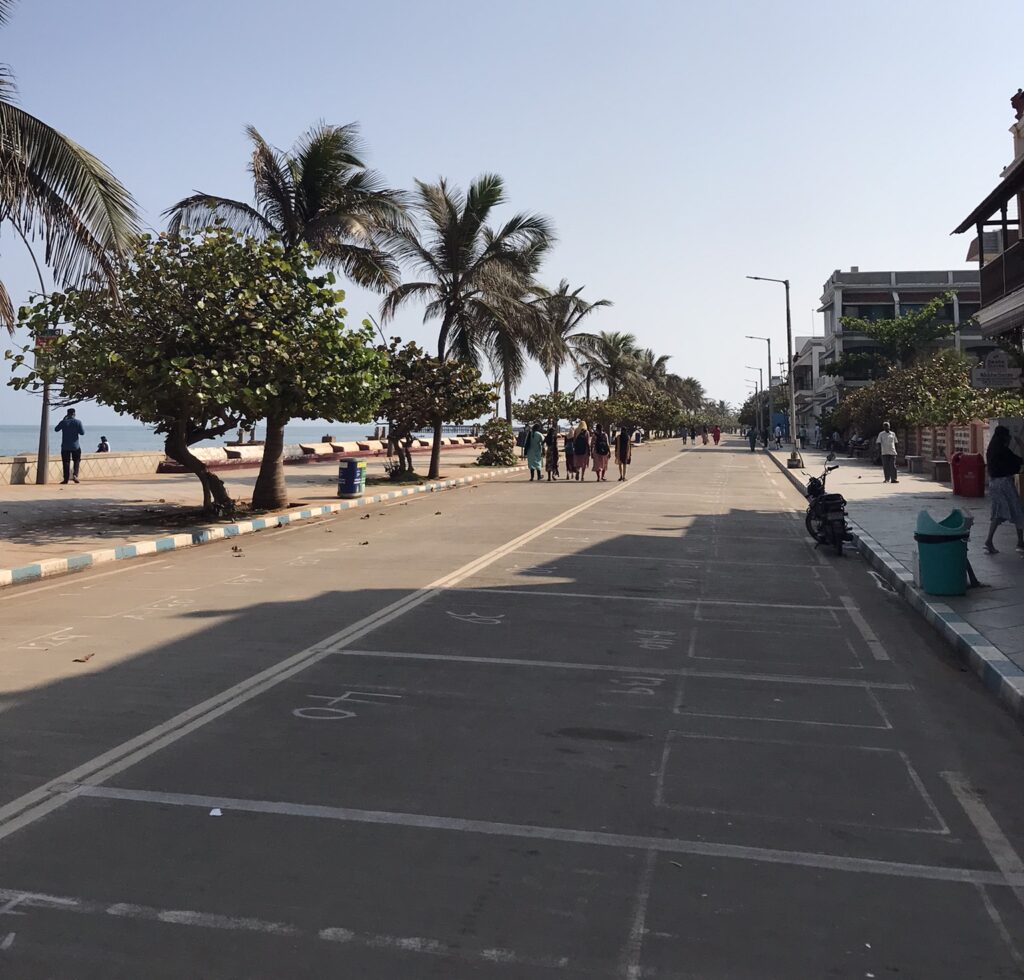
The pedestrianised seafront Beach Road is a good place for a stroll and to avoid the motos
Many local buses run to Puducherry from the East Coast Road. It’s very easy to access by bus from either Chennai or Mahabalipuram. There is also a train station in Puducherry, although it’s not on the British-built mainline so trains can be a little less frequent than in other cities.
Accommodation
La Petit Gite – a French-era heritage house with a central courtyard. It was nice to stay in a place with history and character for quite a good price.
Foodie Places
Baker Street – outstanding food but a mixed experience here. The service was chaotic and erratic with a nonsensical queueing system that was not managed properly. There also isn’t a lot of table space inside, the tables are an awkward shape and the cafe is often overcrowded so eating in is not always the most pleasant experience. We liked the food but in the end there was so much annoyance here that we gave up and started going to Bouchee Sucree as our regular bakery instead.
Cafe de Melon – a strangely quiet restaurant, possibly because it’s a little walk from the main tourist strip. We found the food to be a really high quality and the prices slightly cheaper than elsewhere too. We ate here multiple times – we had seafood pasta, lasagne and beefsteak and enjoyed it all.
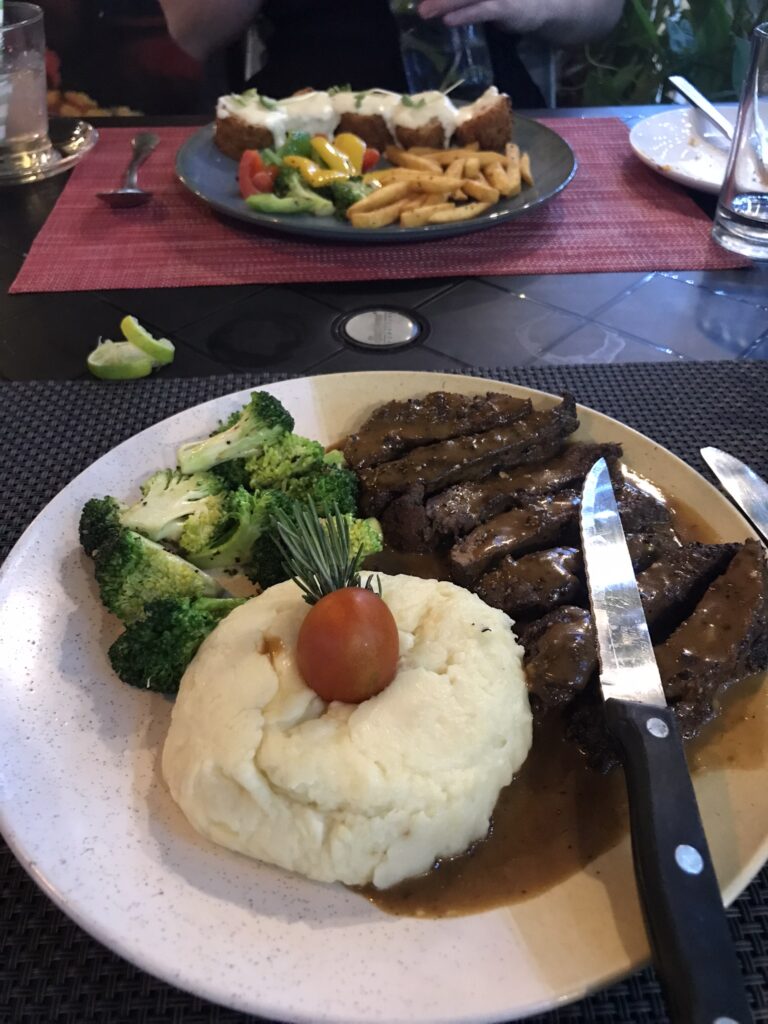
The beefsteak at Cafe de Melon was great
Bel-Ami – a Vietnamese restaurant – understandable as Vietnam is also a former French colony. The food was fresh and flavourful with authentic Vietnamese items on the menu. I particularly liked the pork spring rolls. We were intrigued to find that the server was a born and raised Indian of East Asian heritage from Karnataka state.
Bouche Sucree – a patisserie chain with several branches in the city. Comparatively cheaper than Baker Street and a more comfortable ordering and seating experience. Typical French-inspired cuisine such as croque madame and perfectly-poached eggs on toast. Sometimes the simple things can make a weary traveler happy.

This was very much appreciated
Activities
White Town – it’s nice to amble around the streets of the French quarter, admiring the colonial houses underneath the shade of the leafy trees. Many of the properties seem to have been lovingly restored and maintained, painted in colourful hues of pale blue, dusky rose and mustard yellow.
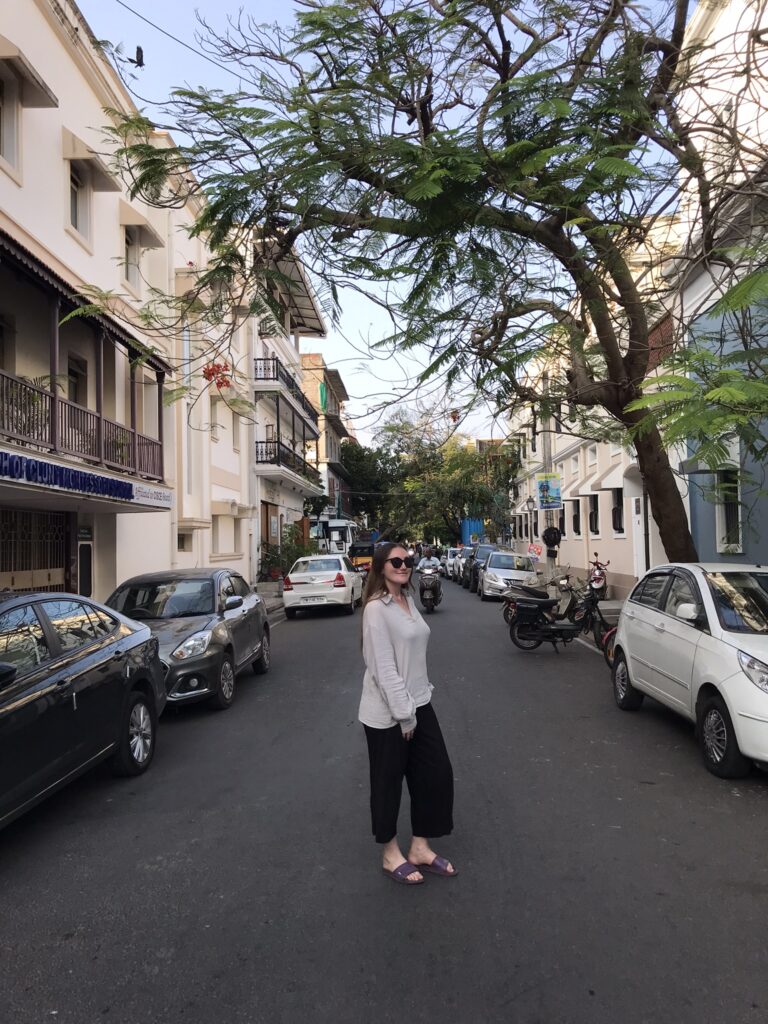
White Town is full of colonial charm
Pondicherry Museum – a small and cluttered museum filled with colonial furniture, furnishings and objects. A bit of a celebration of the French heritage of the city. It’s an old building with no A/C and only a few fans so we were quite hot inside. Some of the items inside are extremely outdated – we spotted information plaques with references that haven’t been relevant since the 1980s.
Churches & Cathedrals – as one might expect given its European colonial past, Puducherry is home to a number of beautiful churches and cathedrals. We particularly liked the pastel-pink Notre Dame des Anges Cathedral, which is extremely photogenic. A really pretty little church. We were also interested to stumble across a Christian hymn being sung in the Tamil language at the Sacred Heart Basilica. Interestingly, the local custom is to take off your shoes before entering a church – possibly a tradition that was brought across from Hinduism.
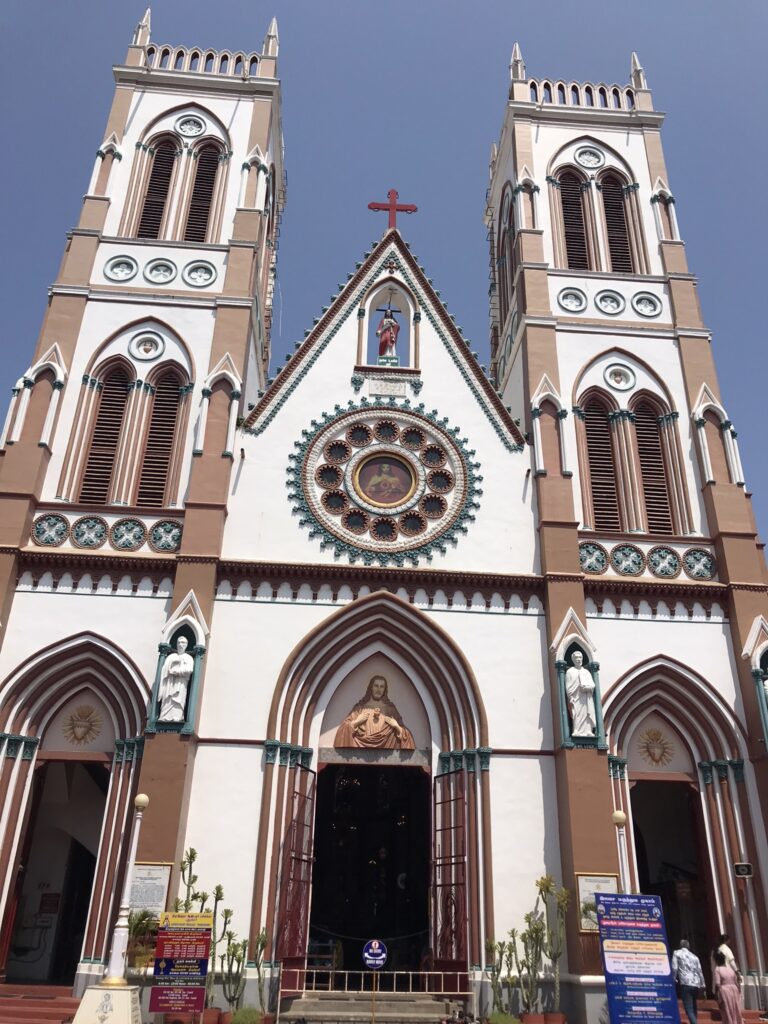
The colonial churches are particularly grand in Puducherry
Thanjavur
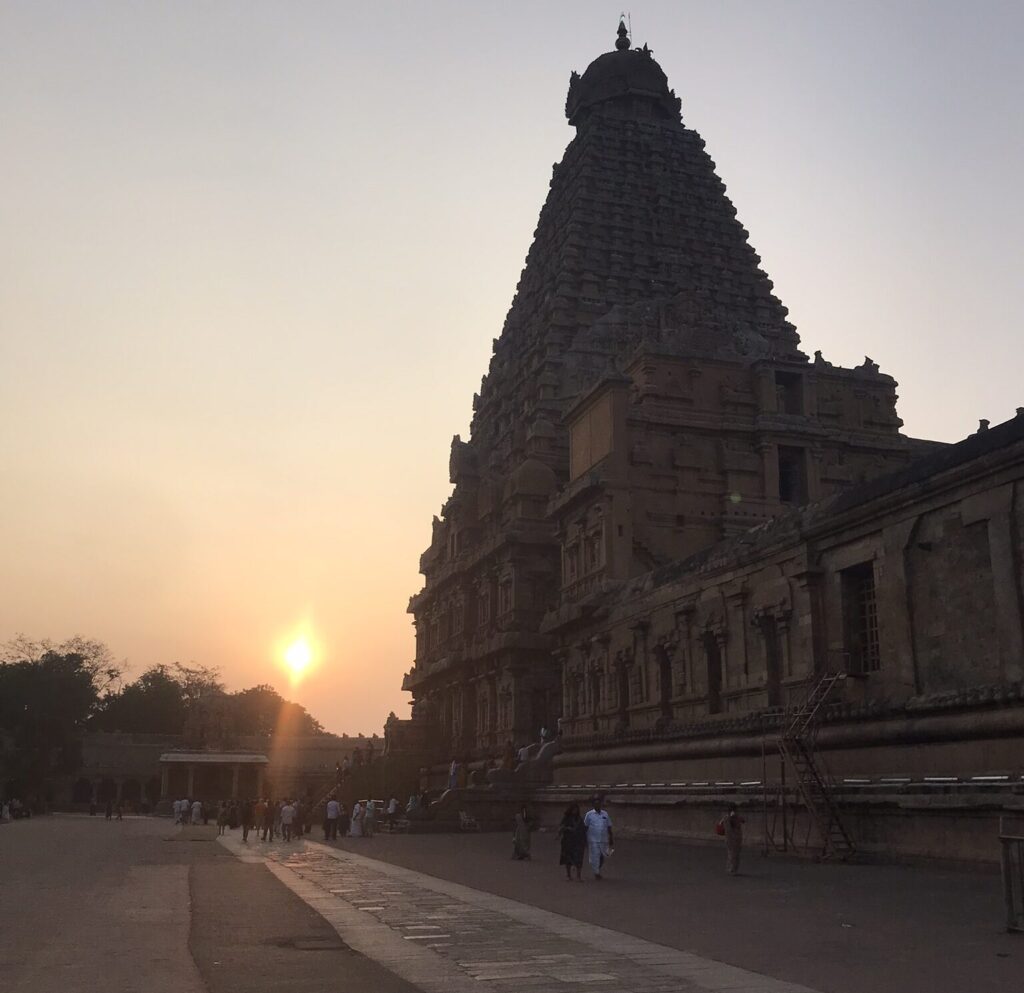
Located inland, a long way from the touristy strip along the coast, Thanjavur was a key city and capital of the Chola Empire, who at their peak in the 11th century controlled most of southern India as well as parts of Sri Lanka and South East Asia. During their heyday in Thanjavur, the Cholas constructed the Brihadisvara Temple – otherwise known as the Big Temple. At over 60 metres tall, this thousand-year-old structure is still one of the largest and most impressive Hindu temples in India.
The temple is the centrepiece of a large, atmospheric complex which is filled with elaborate carvings and thronging with devotees. Along with two other smaller Chola constructions in the region, the Brihadisvara Temple has been recognised as a UNESCO World Heritage Site. Despite its historical value and amazing architecture, Brihadisvara Temple is still a working temple and major Hindu pilgrimage site.
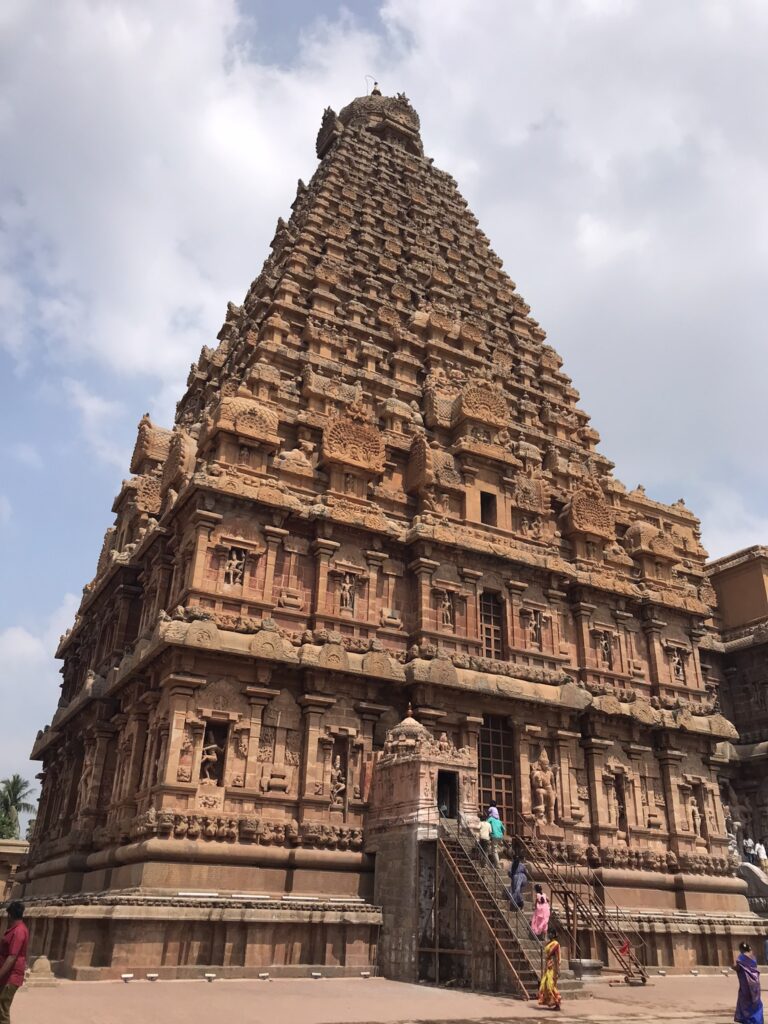
The temple is huge and seriously impressive
Following the decline of the Cholas, the city was passed through several local dynasties over the centuries before ending up under control of the British Raj. The temple however remained and stands as a testament to the archaeological brilliance of the time. Later, during the era of dynastic rule around the 1600s Thanjavur became known for its distinct style of painting, known as Tanjore painting. Paintings of this style can often be spotted at art galleries throughout India.
Outside of its famous temple complex, Thanjavur felt like a typical medium–sized Tamil city. The centre of Thanjavur is busy and bustling but not as chaotic as some other places in India. There are colourful small temples, roadside market stalls selling fruit, some British colonial aspects as well as remnants from the eras of local dynastic rule before the British occupation. One such building is the Royal Palace Complex, which was used by the local rulers during the 17th and 18th centuries and is now (somewhat) open for the public to visit.
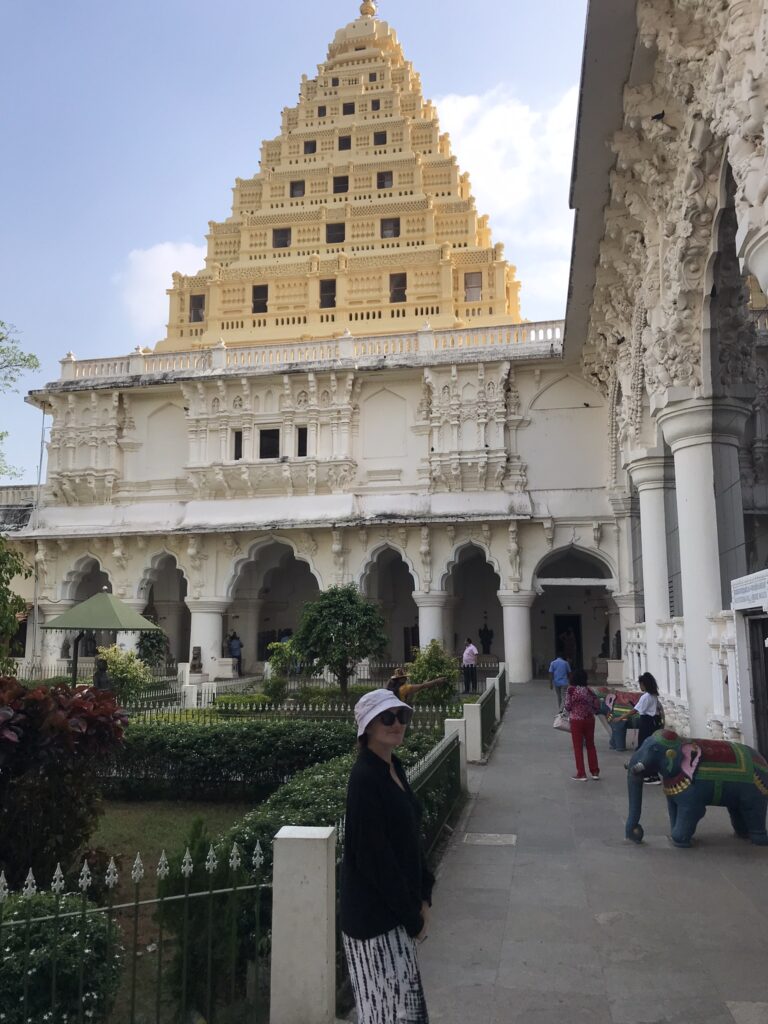
The Royal Palace Museum contains an art gallery and the Saraswathi Mahal Library, which is well worth a visit
Thanjavur has a typically hot South Indian climate, but it didn’t feel as humid to us as the coastal cities. We walked around all day and didn’t feel exhausted or drenched in sweat as we did on the coast. There are not too many foreigners around – the only other white faces we spotted were a few French-language tour groups in the temple complex. Locals were a little surprised to see us but also very friendly, welcoming and didn’t hassle or bother us at all in the city.
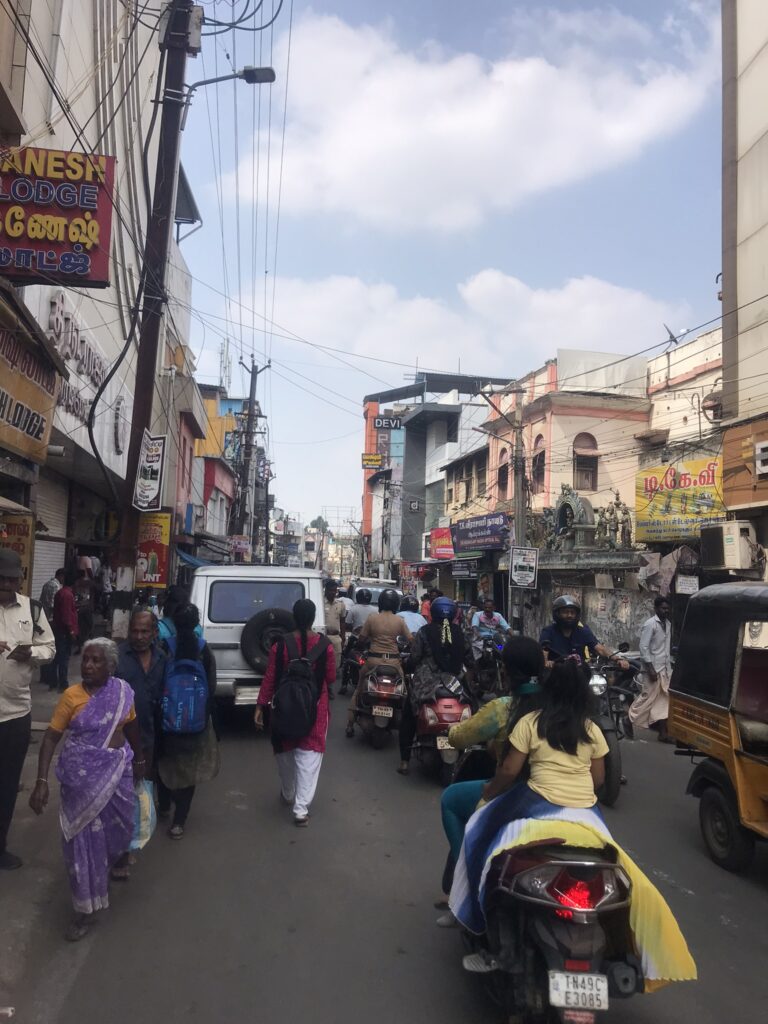

On the streets of Thanjavur
Thanjavur is pretty easy to access by rail as it is a junction station and sits on a major east-west train line. We were able to get a direct train from Puducherry and also a train from Thanjavur back to Chennai. The station is close to the centre of the city and within walking distance of most attractions.
Accommodation
Philomena Hotel & Apartment – a surprising hit with us. Large, pleasant and modern rooms and professional service, particularly from the female receptionist. The hotel is located within walking distance of the train station. It’s a little further to the temple complex, but still walkable for fit and able travelers.
Foodie Places
Sree Ariya Bhavan – a great place for typical south Indian cuisine such as dosa, idli and idiyappam along with all-you-can-eat rice refills. The food is served on a banana leaf. We had a feast here, we ordered far more than we were able to eat in the end as we wanted to try all the dishes. The prices are so low that we still didn’t come close to breaking the bank. They also do thali and lunch deals.
Don’t miss the rose milk, an unexpected delight! A very popular restaurant with a bustling and lively environment, there were many larger groups and families celebrating special occasions here as well as couples and even solo diners. We were the only foreigners and the staff were eager to look after us and help us with recommendations (including how best to actually eat the variety of foods that we’d ordered!). The actual restaurant is located on the top floor, the bottom floor is a sweet shop.
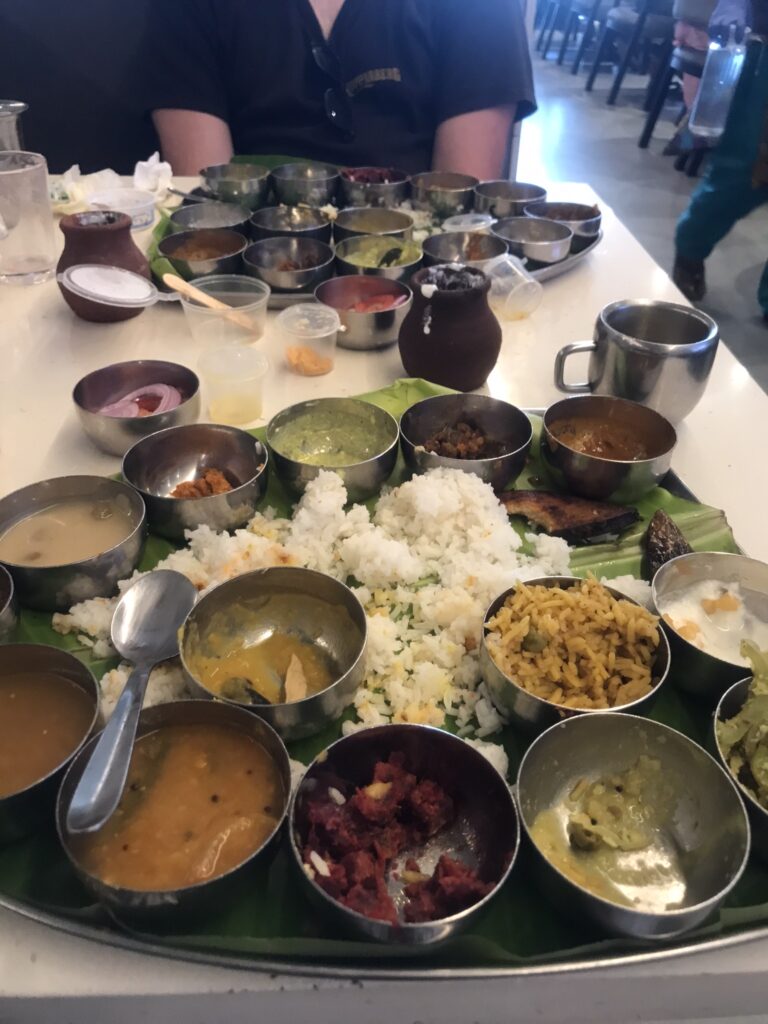
An absolute feast at Sree Ariya Bhavan
KFC – this was close to our hotel, sadly resorted to after we had eaten several times at Sree Ariya Bhavan and had as much South Indian food as we could handle. Honestly, the chicken here wasn’t bad. I’ve had much worse KFC in other cities and countries.
Activities
Brihadisvara Temple Complex – the focal point of the city for most visitors. An enormous temple complex dating back over 1000 years to the Chola dynasty, I would rate this as the most impressive of the many many Hindu temples that we saw in the whole India. There are several tertiary shrines as well as the eponymous Big Temple.
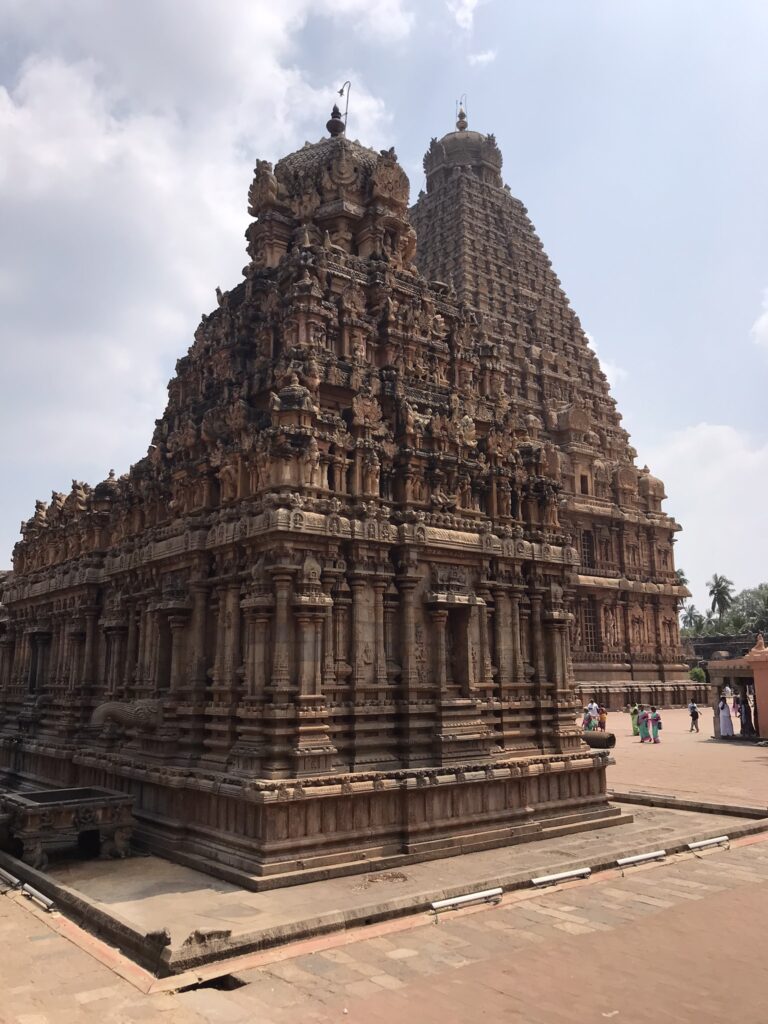

There are many smaller shrines to explore within the complex
As it’s a working temple complex, shoes are forbidden inside. The shoe depository before going in cost us 10 rupees per pair. The shoe depository is actually before the main security checkpoint. There was a persistent beggar woman hassling and grabbing at people near the shoe depository, which was strange to see within the temple setting. There aren’t many foreigners around – the few foreign tourists we encountered mostly seemed to be French tour groups. Quite a few excited locals inside wanted to take photos with us – some local parents even handed me their baby to take a photo with.
Absolutely every part of the complex is intricately carved, from the gopuram gateways to the various smaller shrines and the main temple itself. It’s impossible to resist taking photos of the temple from all angles. Also don’t miss the wall painting in the chambers surrounding the courtyard and the enormous statue of Nandi, the sacred bull – this is said to be the second largest Nandi statue in the world.
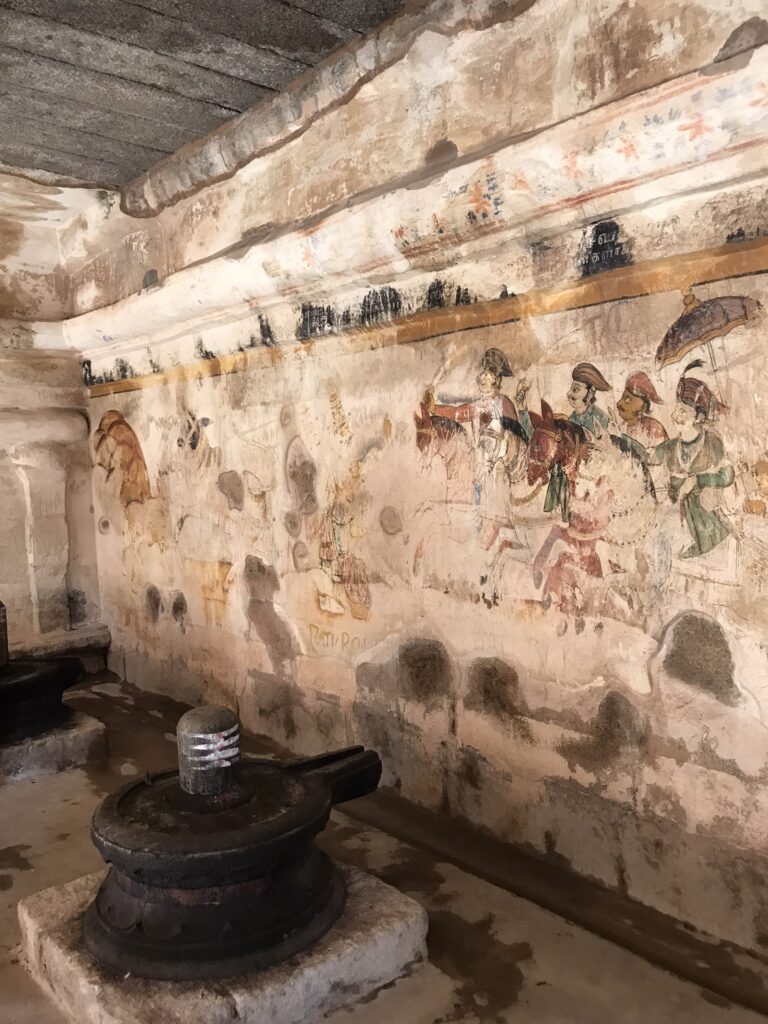

The entire complex is intricately carved and the outer courtyard is filled with wall paintings
It’s possible to go inside the big temple but be ready for a queue of devotees trying to enter and some pushing and shoving in the interior. The entrance to the big temple itself is from the same direction as you enter the main complex.
Rituals, blessings and prayers seemed to be happening all around. It was particularly poignant seeing the devotees seated on the ground assembling their flower offerings. Entry is free so you can visit multiple times. I recommend visiting during the day to explore the large complex, and then returning at sunset as the temple is beautiful at night. The golden sunset hues are not to be missed. The temple atmosphere is vibrant around sunset with many devotees attending for the evening rituals. This temple is a timeless wonder.
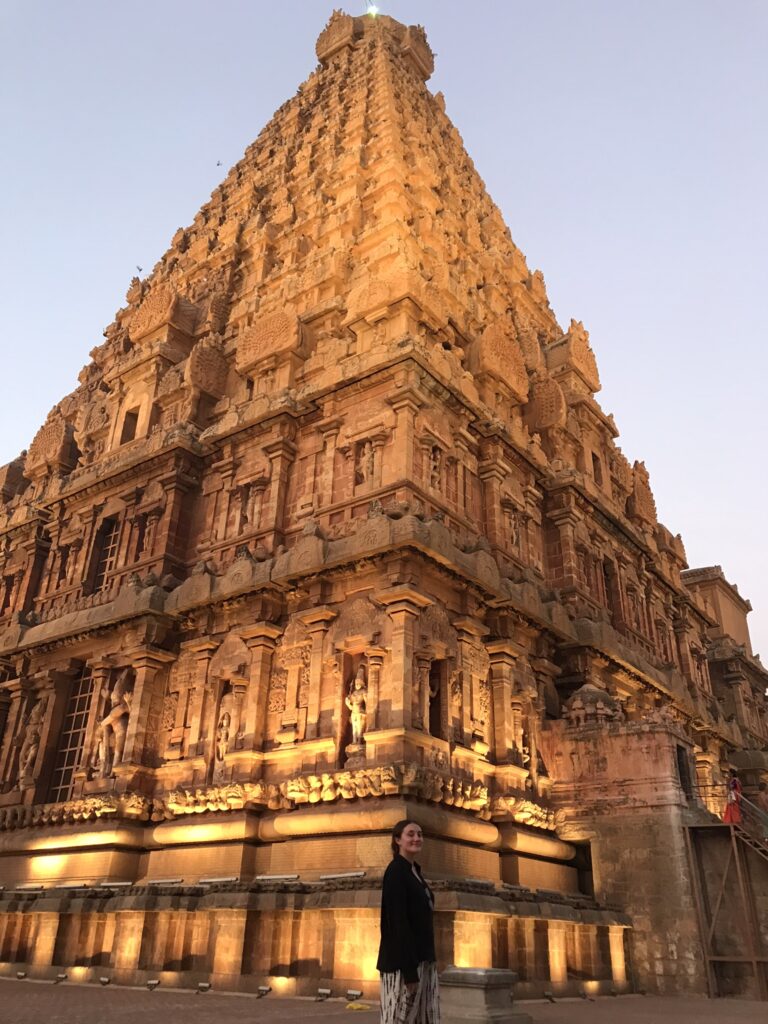
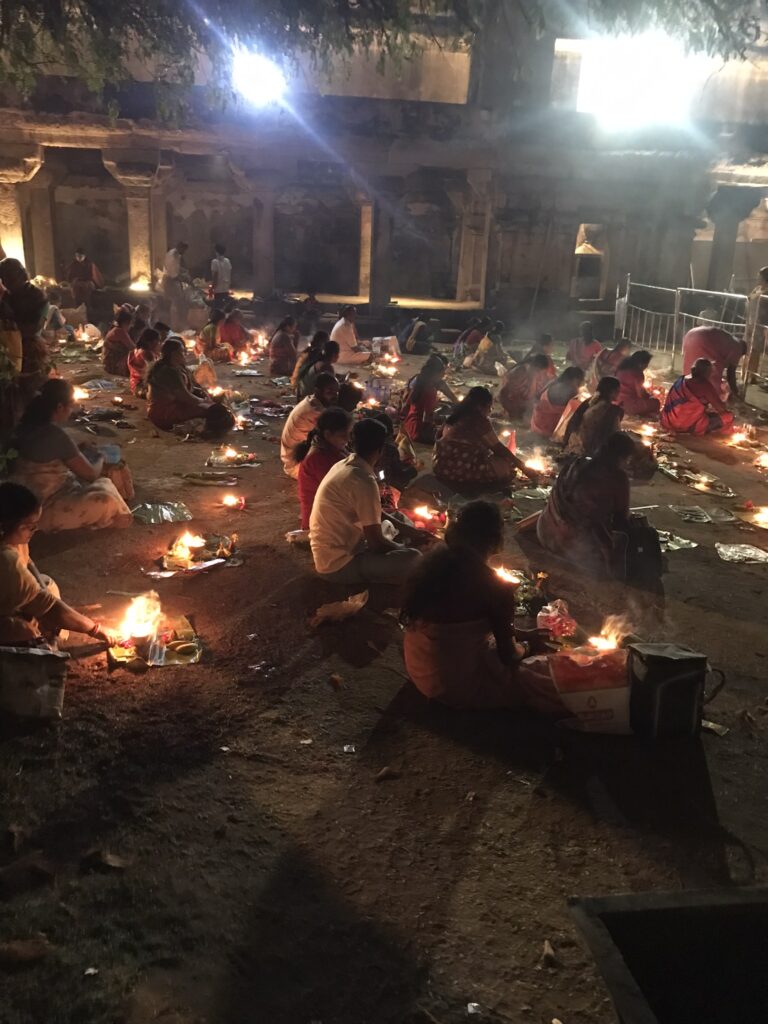
The temple is particularly special around sunset
Royal Palace Complex & Museum – an interesting complex with several different aspects. The ‘Palace Museum’ ticket includes the Saraswathi Mahal Library, art gallery and bell tower as well as an audio-visual film promoting Thanjavur and talking about the region’s heritage. The film is in Tamil with very fast English subtitles which made it difficult to follow. There were hourly showings from 10.30am to 4.30pm when we visited. After the film, we were able to enter the library with the rest of the viewers. I’m not sure if it’s mandatory to watch the film or not.
The Saraswathi Mahal Library is supposedly one of the oldest libraries in Asia, dating back to the 1600s and having survived through several different ruling dynasties. The library was a treat, containing very many weird and wonderful assorted manuscripts from bygone decades and centuries – old world maps, technical drawings of plants and animals, Thanjavur-style paintings and pictures of the local maharajas, images of London and the English countryside, questionable medical charts and documents, Sanskrit inscriptions, Hindu religious material, a gallery of Chinese torture methods with pictorial diagrams. A treasure trove for those interested in quirky antiquities.
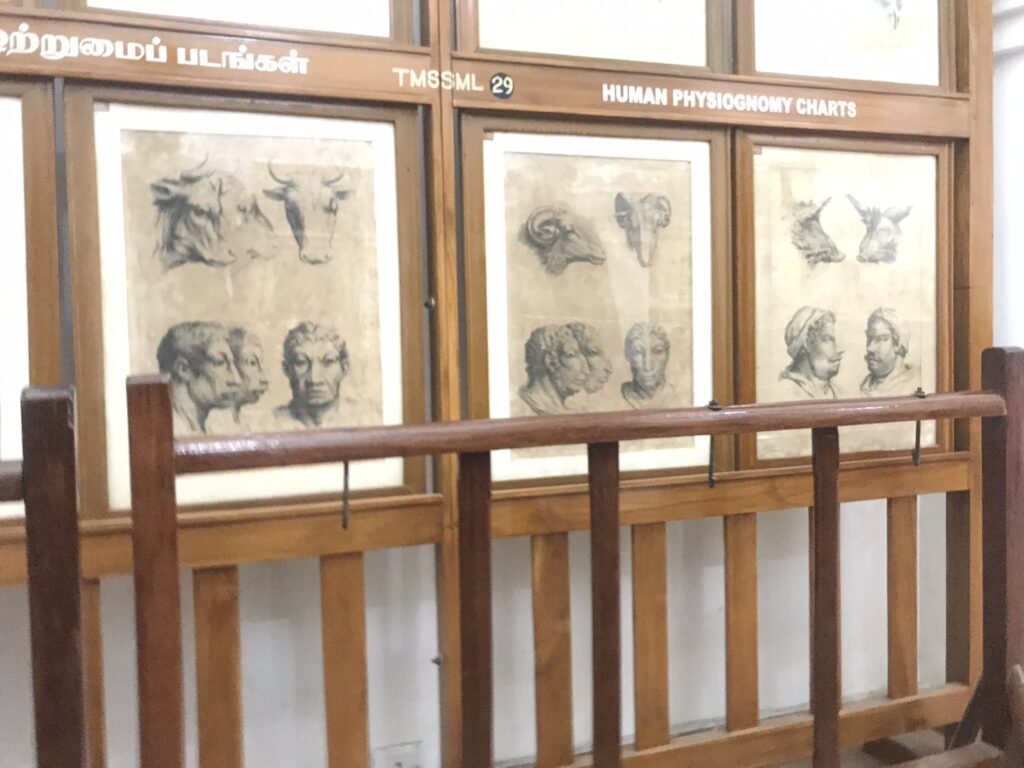
I’m not sure about this
The art gallery section of the museum mainly just consisted of pretty standard Hindu sculptures and bronzes, situated in a very grand building within the palace complex. Upstairs was a small photo gallery. The bell tower was also listed on the ticket, but it seemed to be pretty deserted and we weren’t able to go up the tower or do anything other than look at it from the ground.
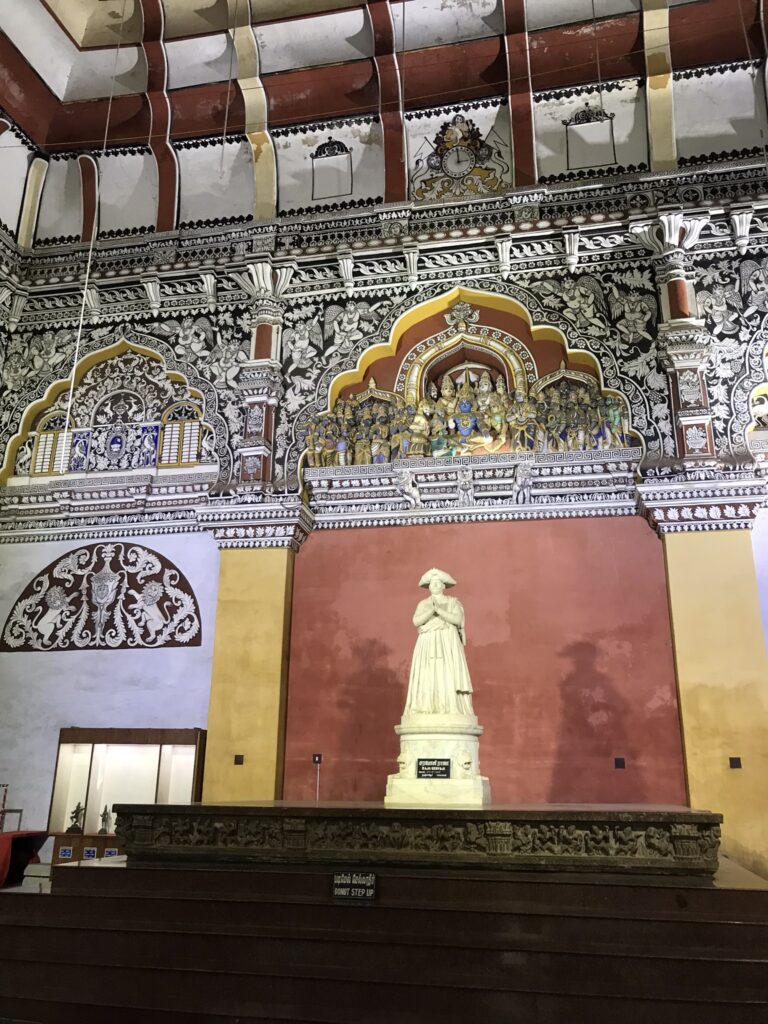
The building containing the art gallery was very nice – inside are various sculptures and bronzes, as well as a photo gallery upstairs
The Royal Palace Museum is not to be confused with Thanjavur Museum, a large building which we spotted near to the Big Temple which contains a few Thanjavur heritage items and a bird park.
